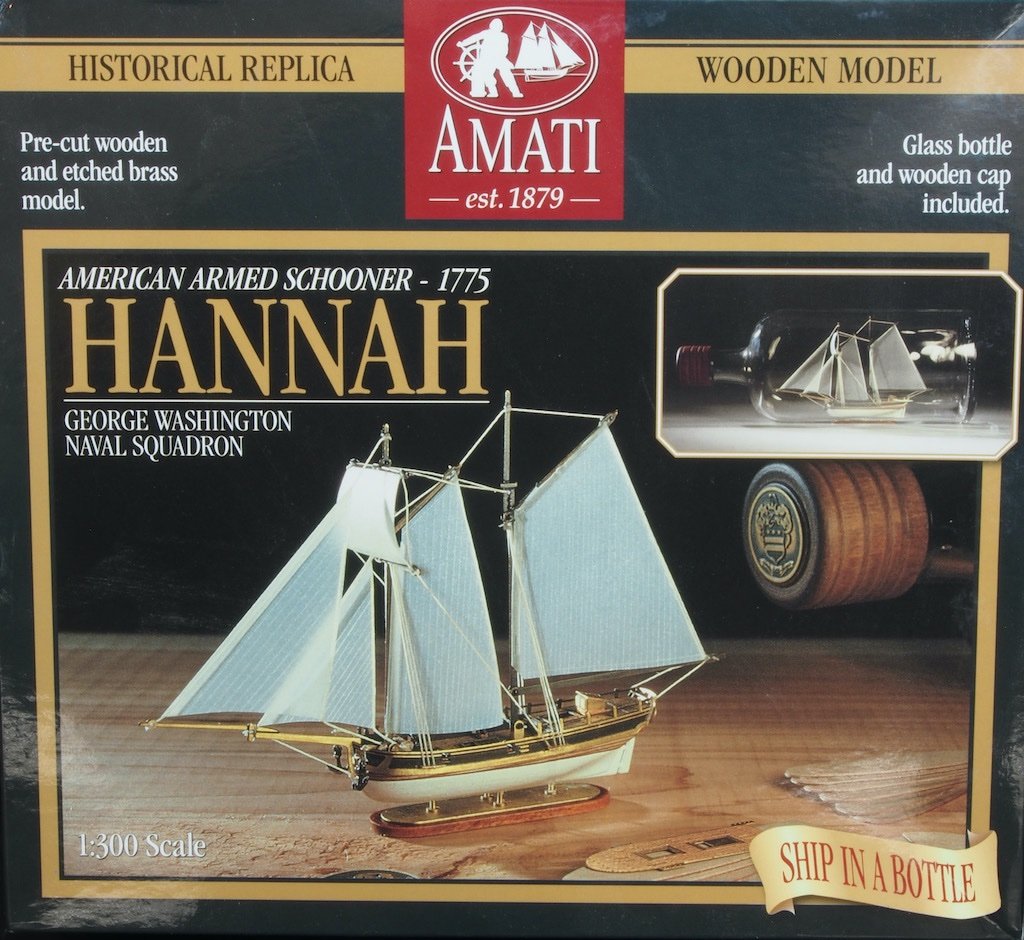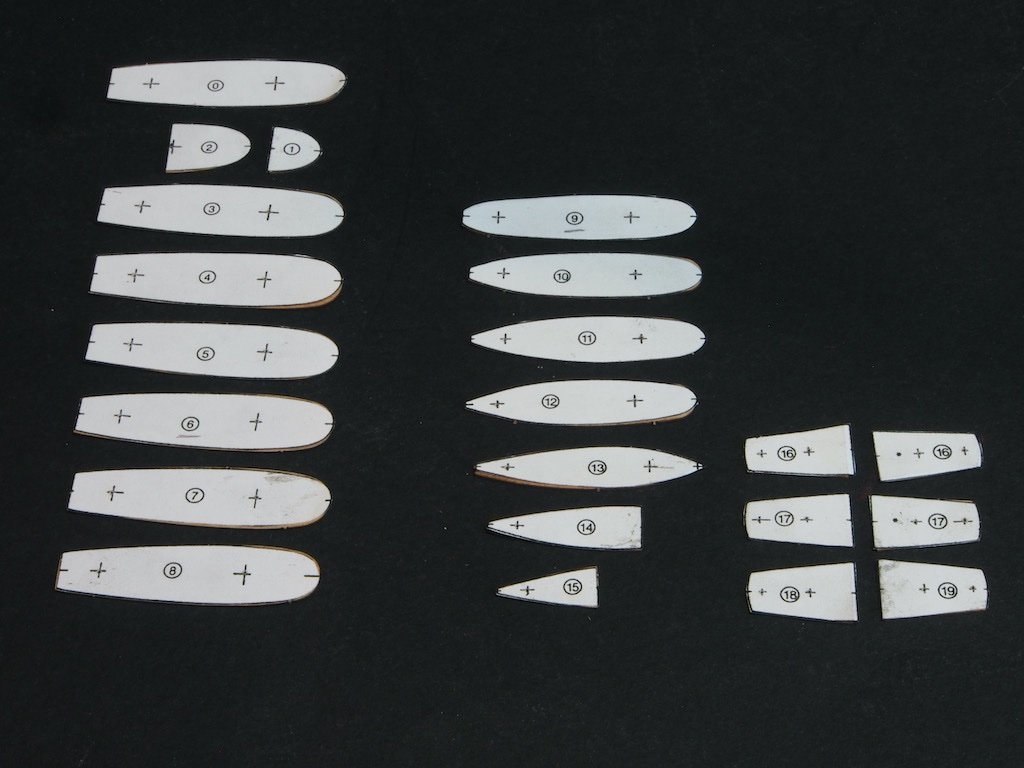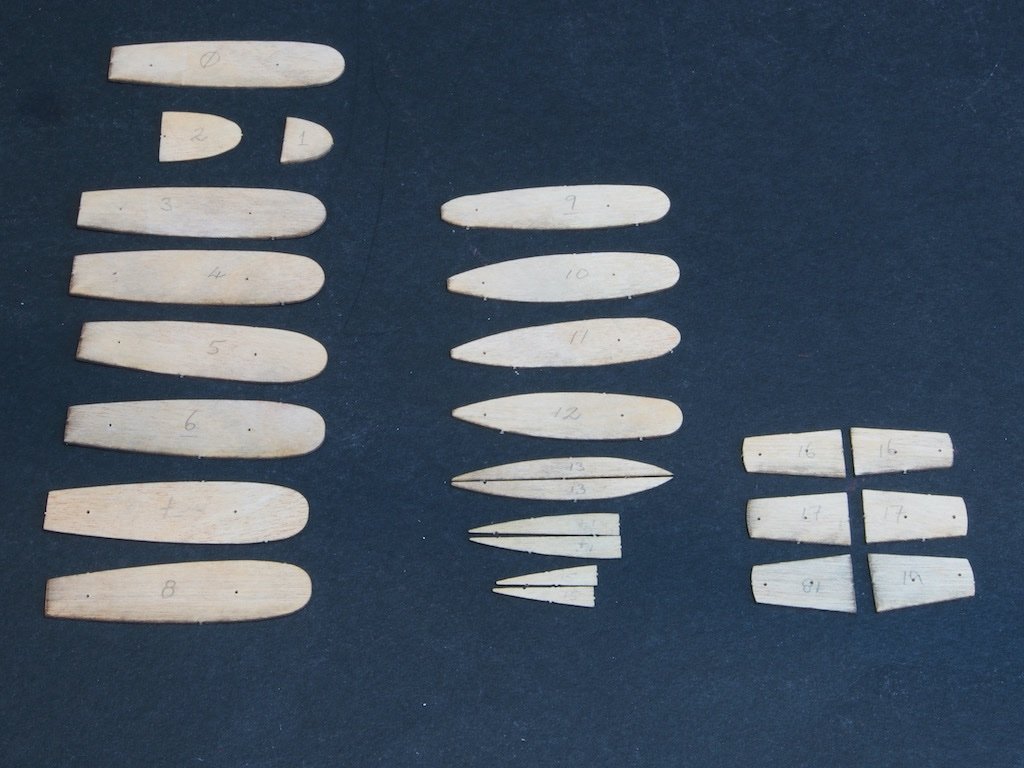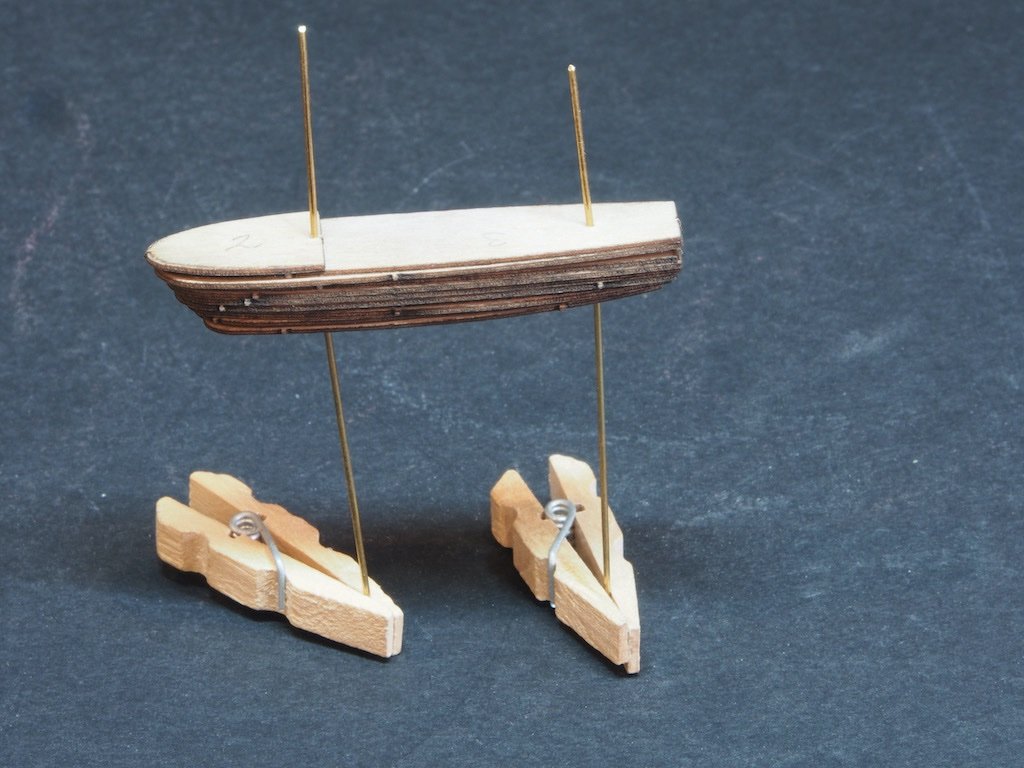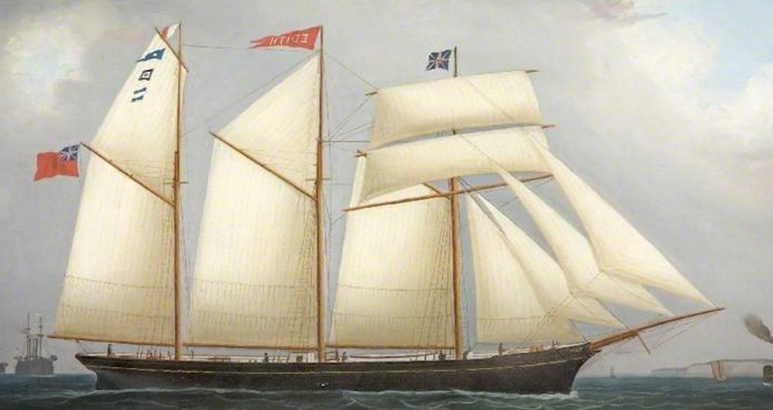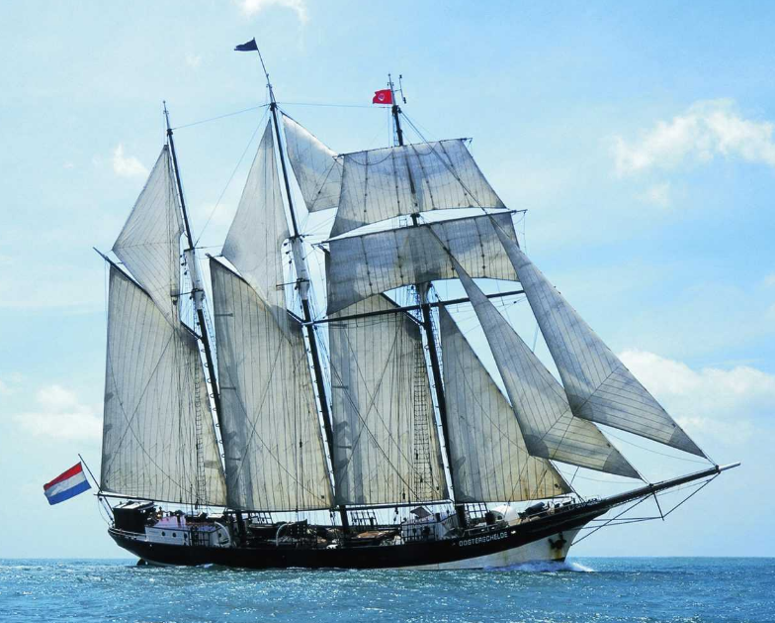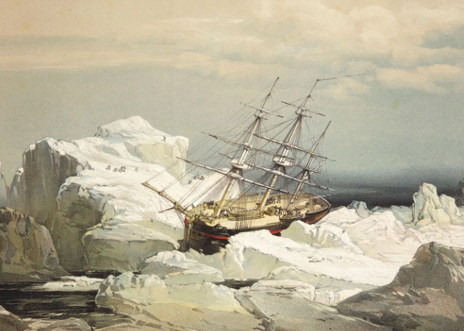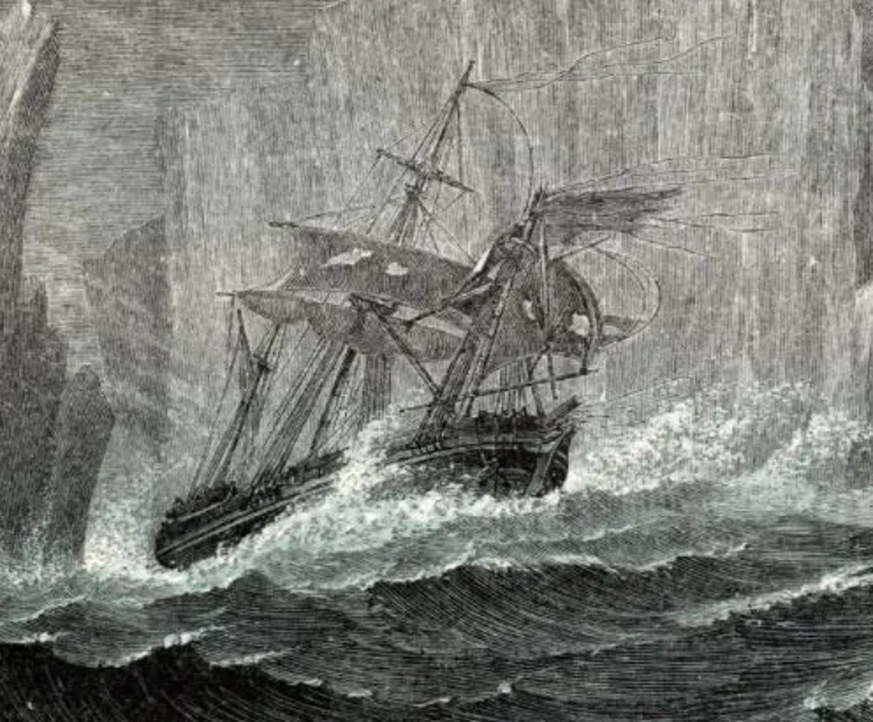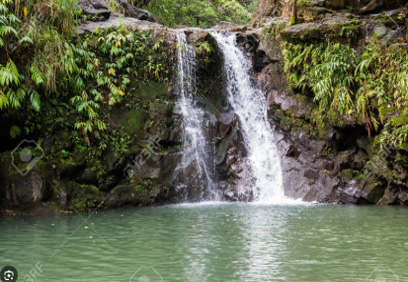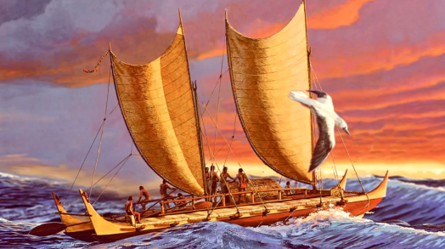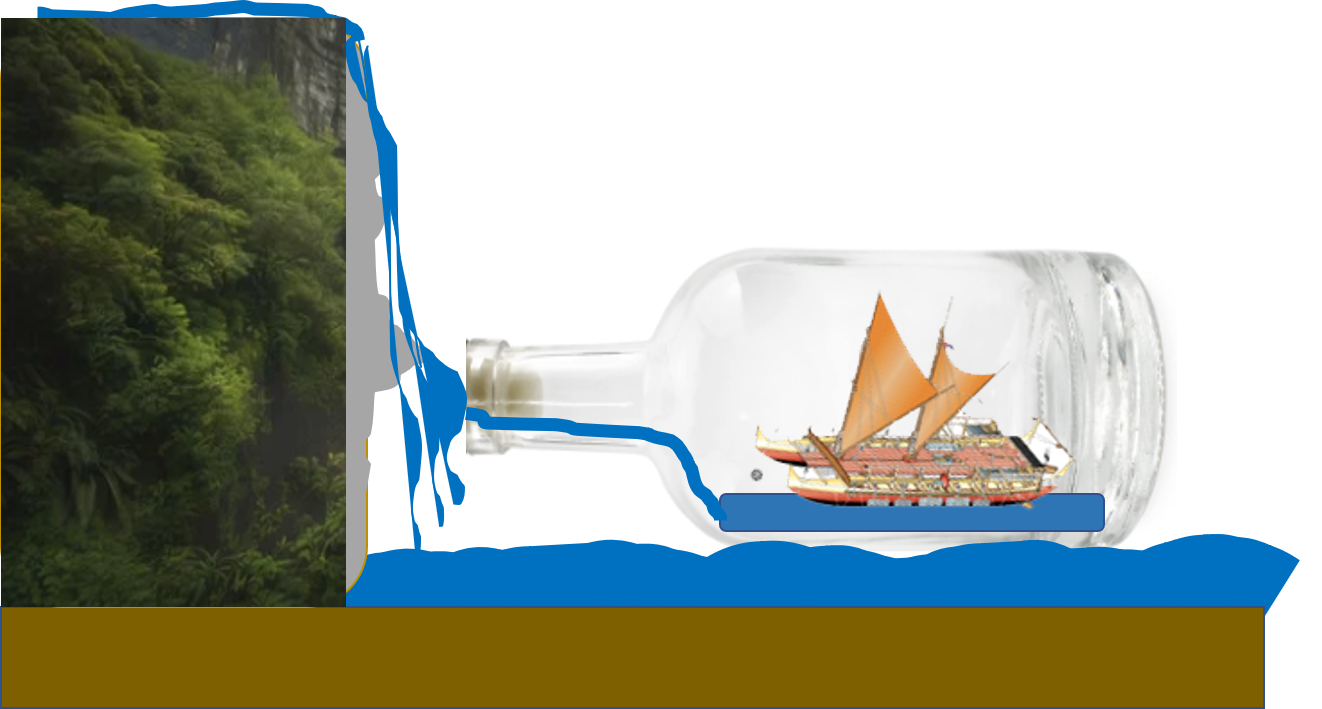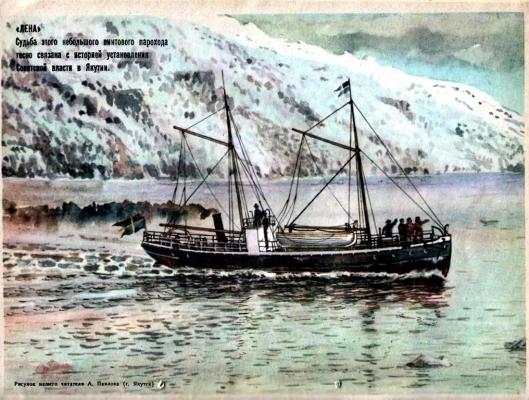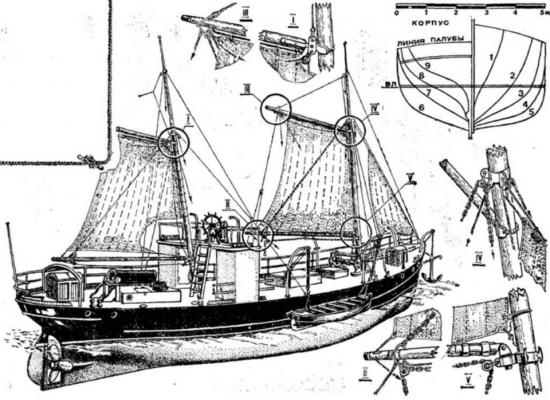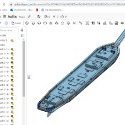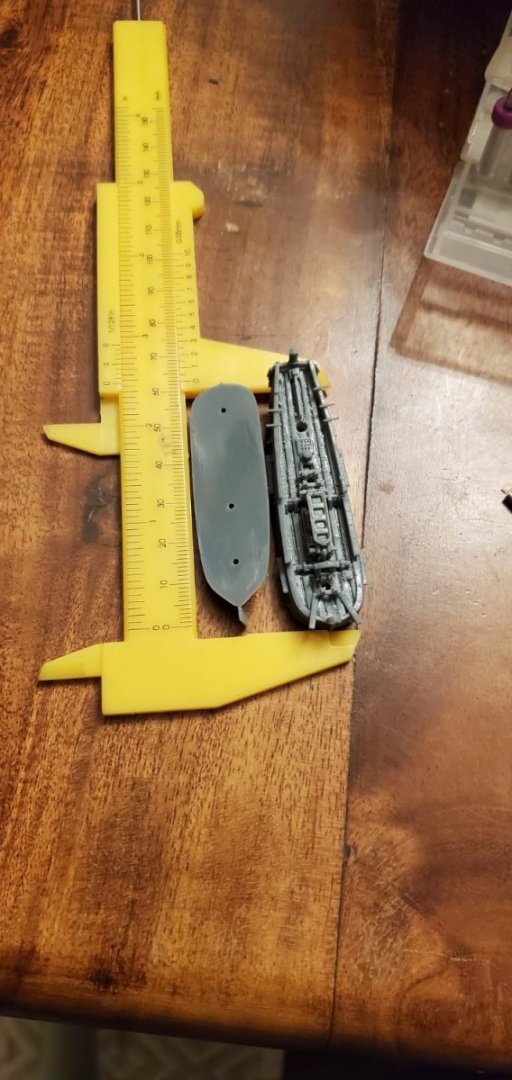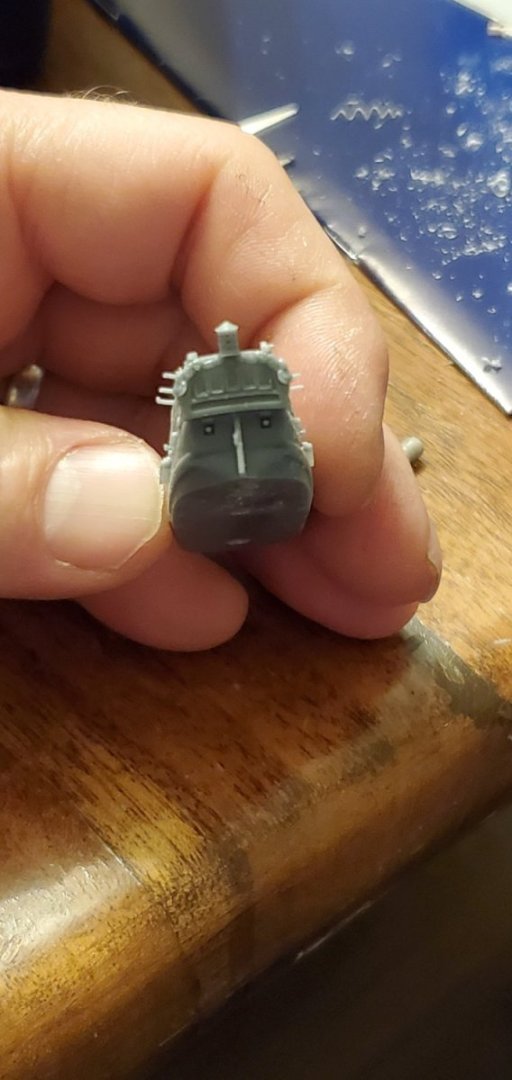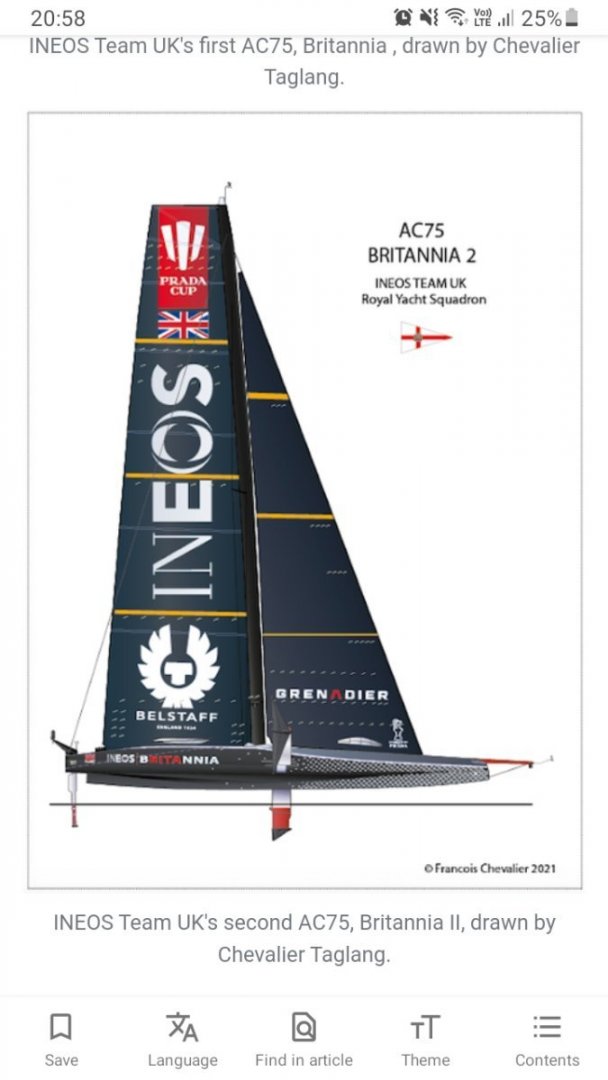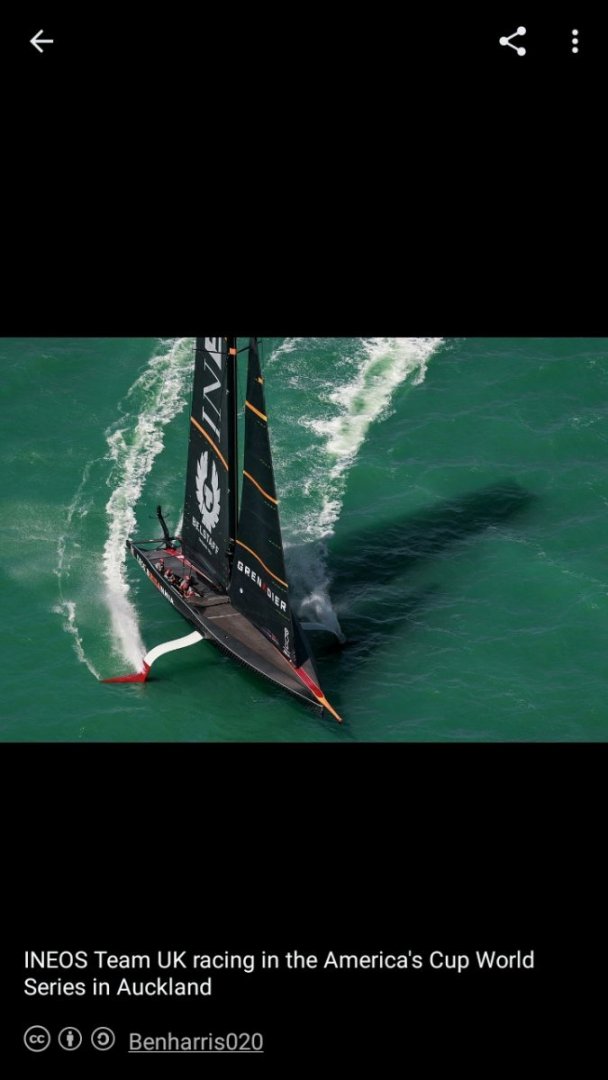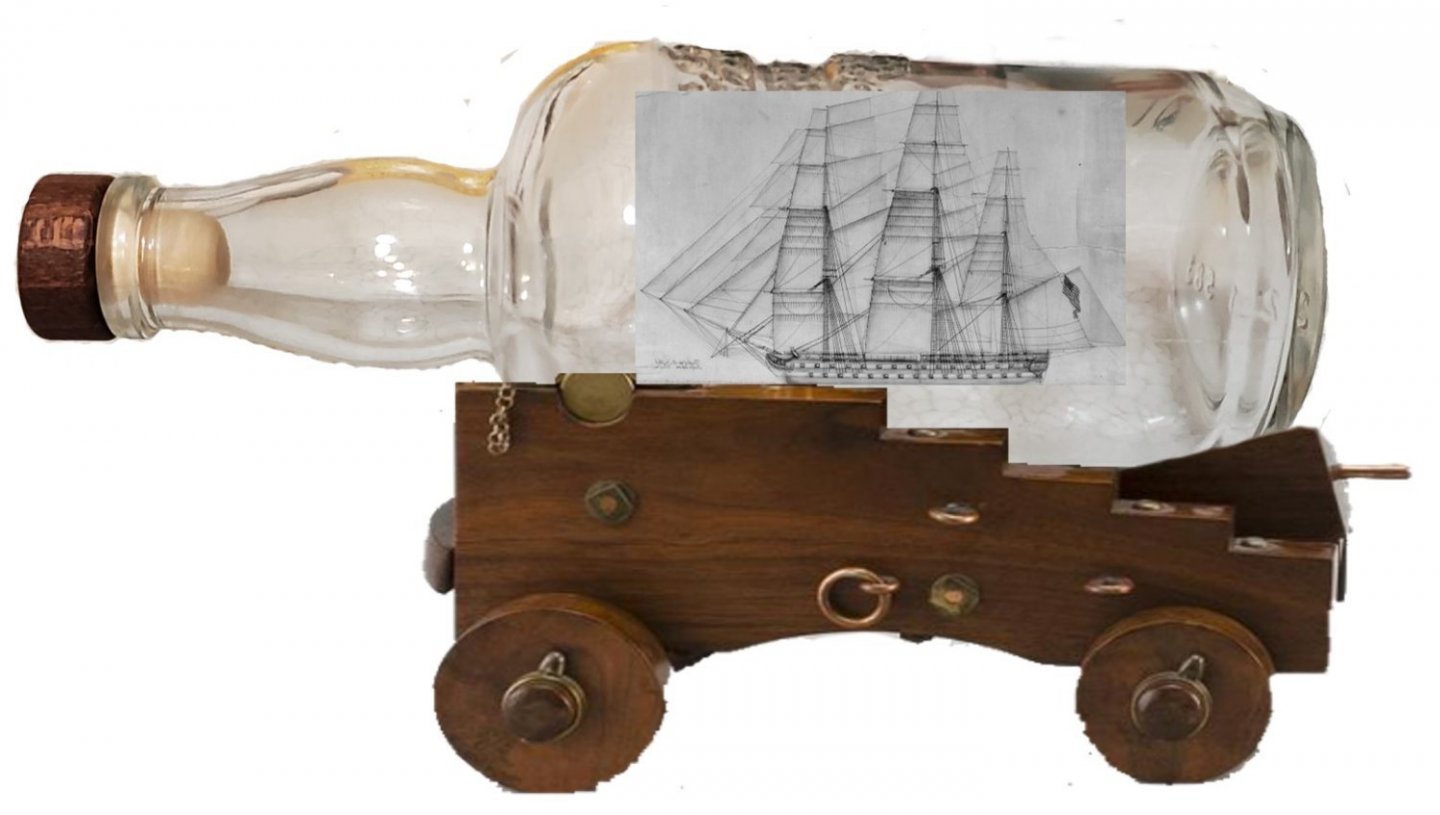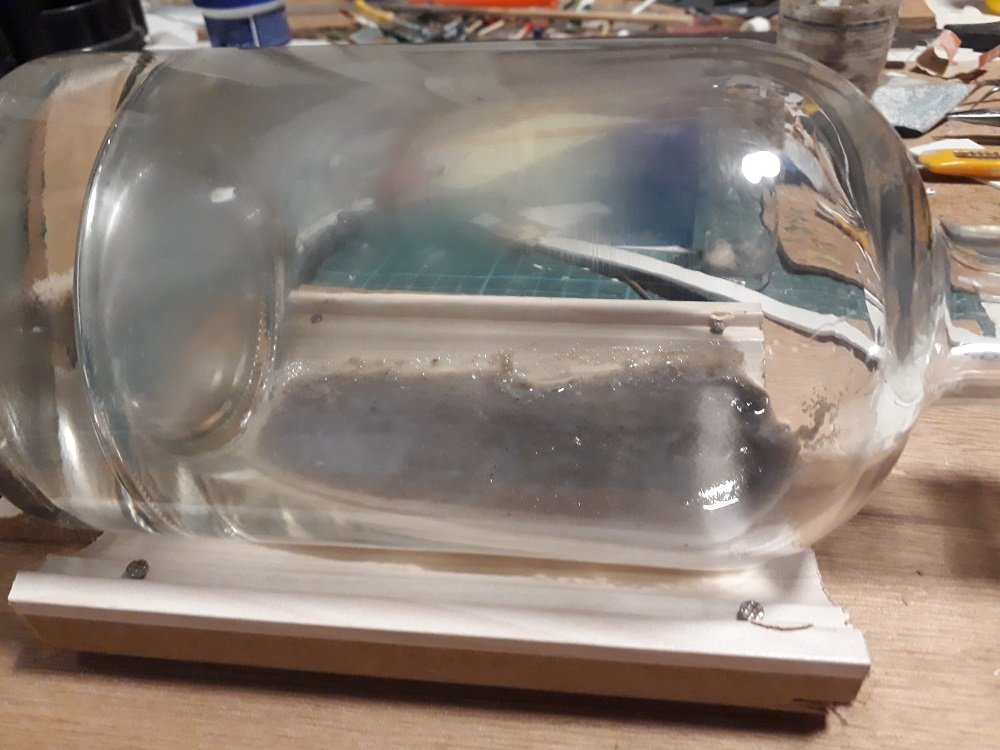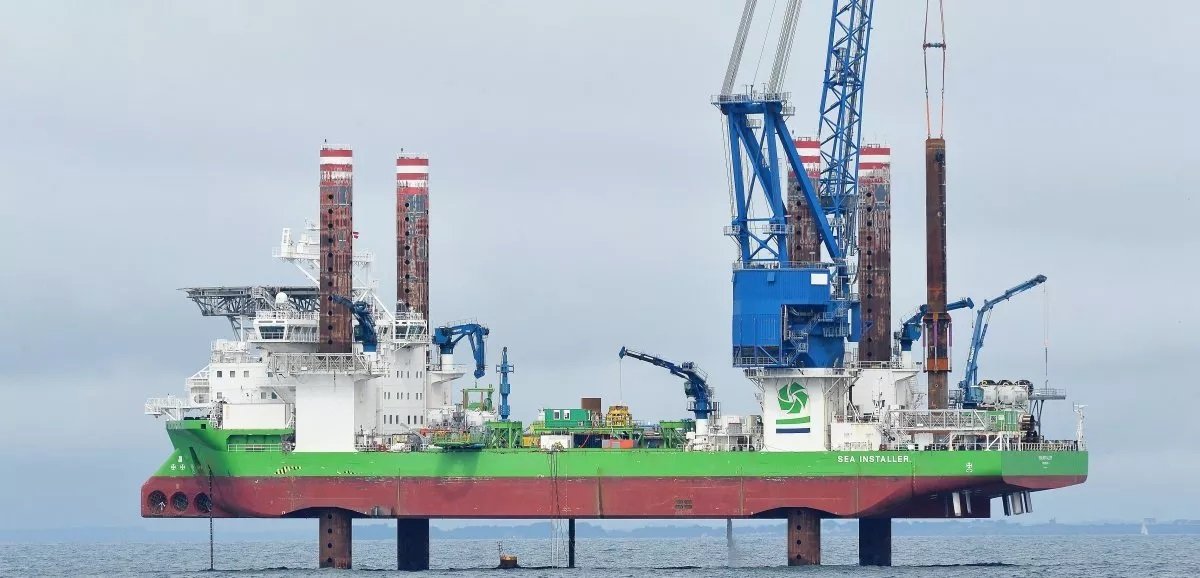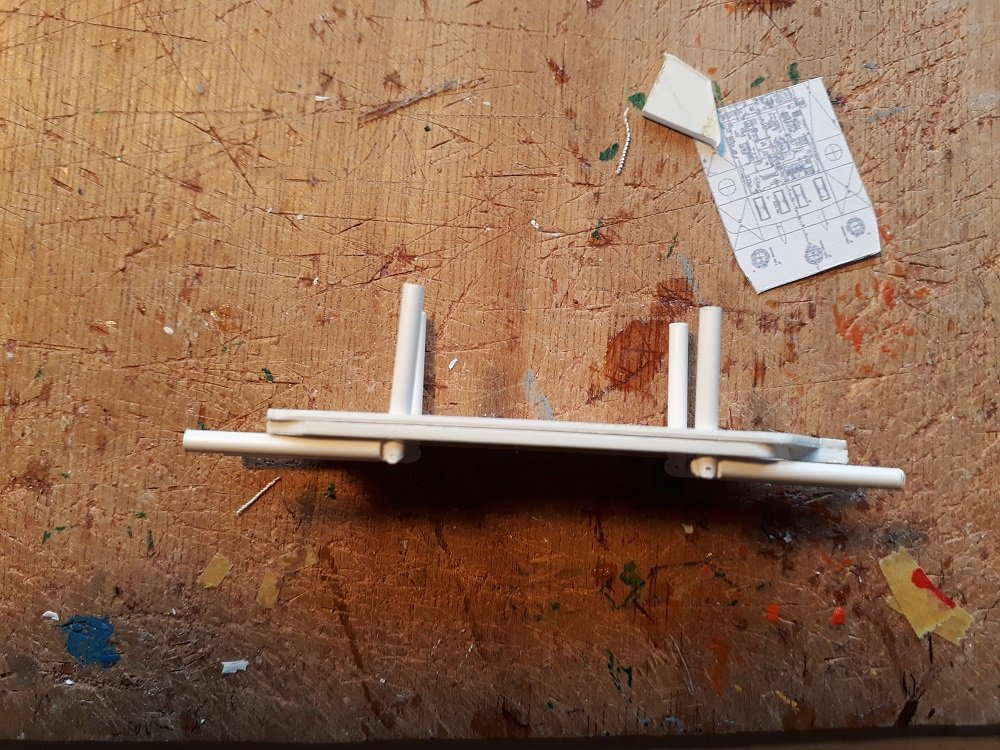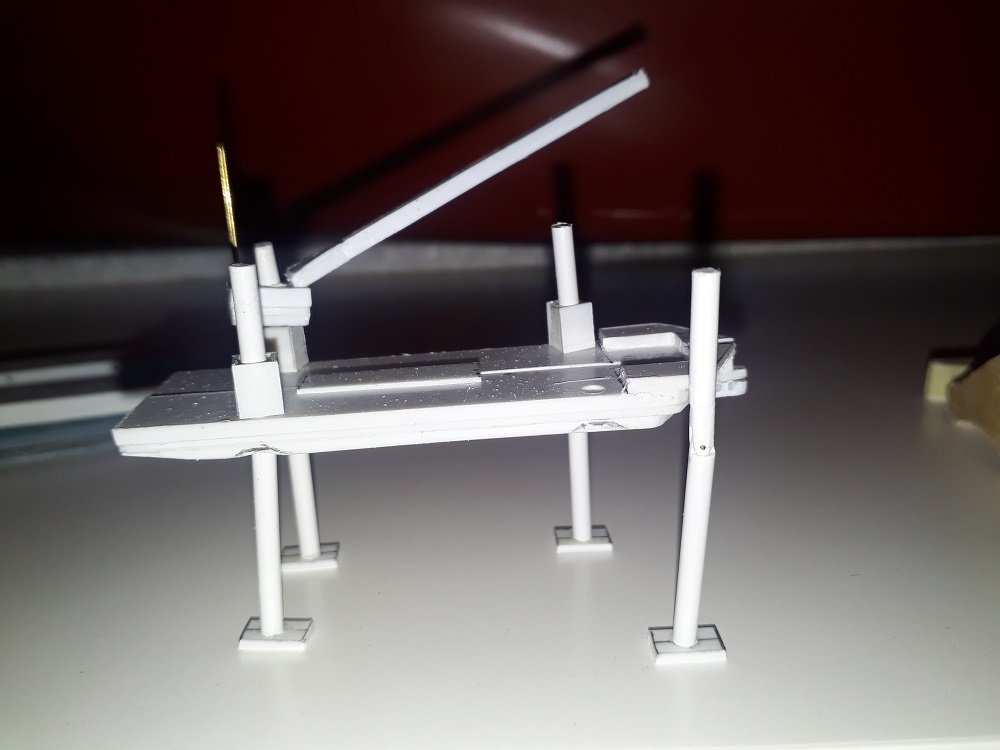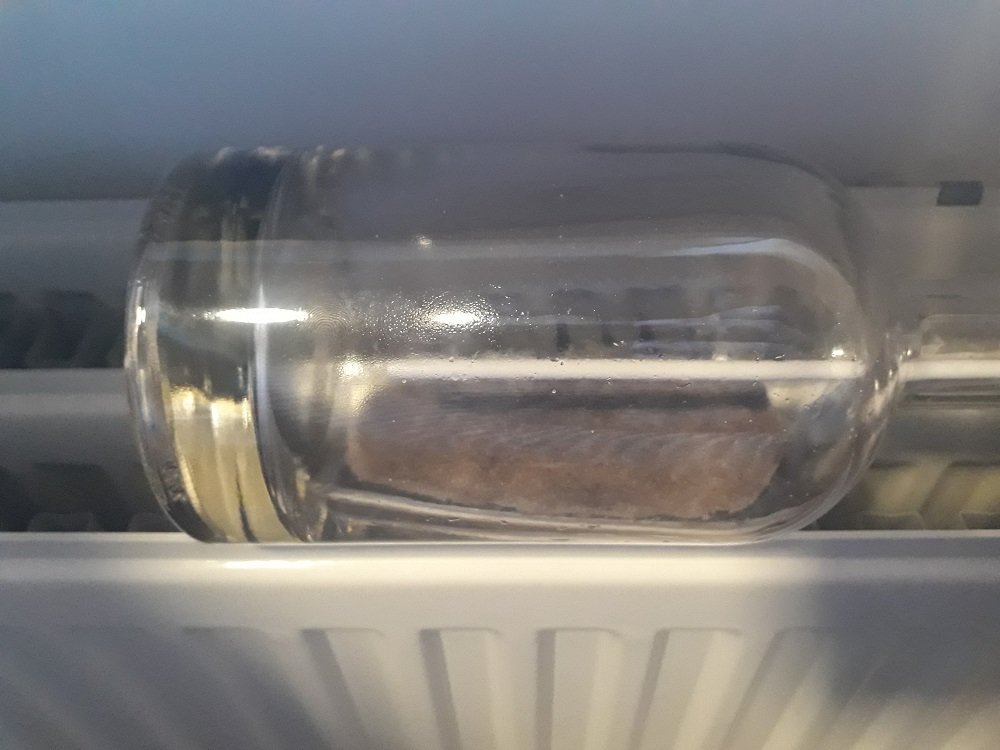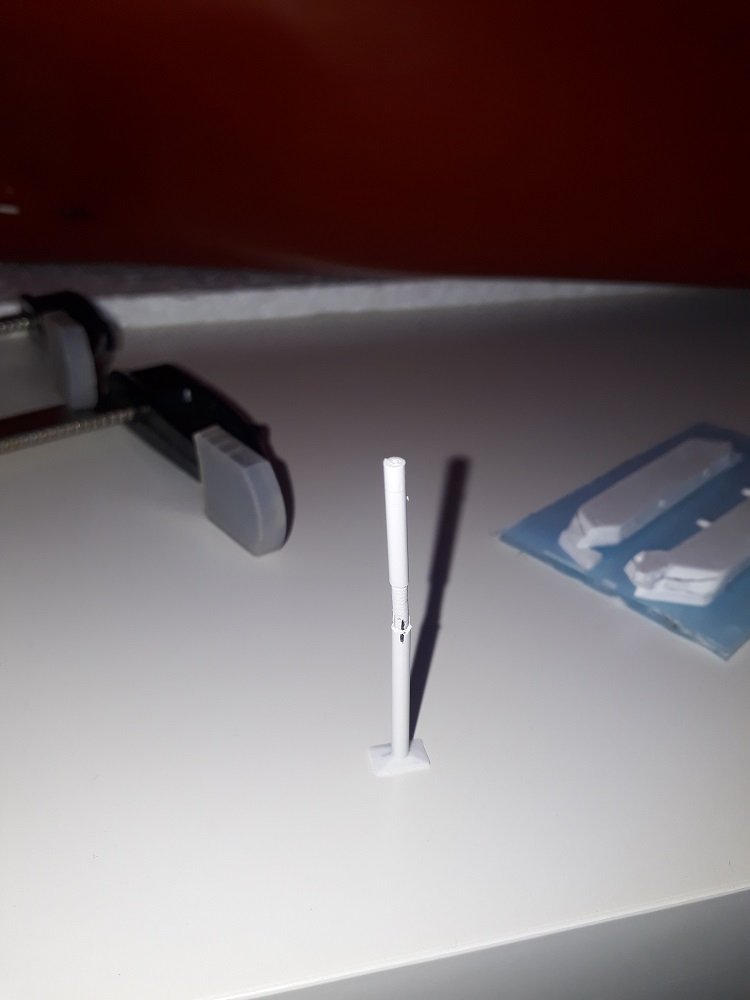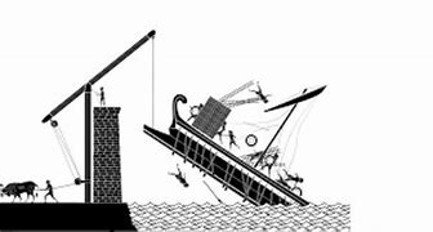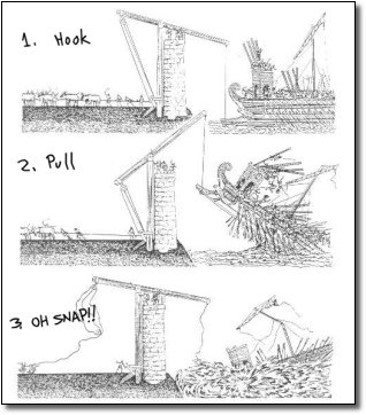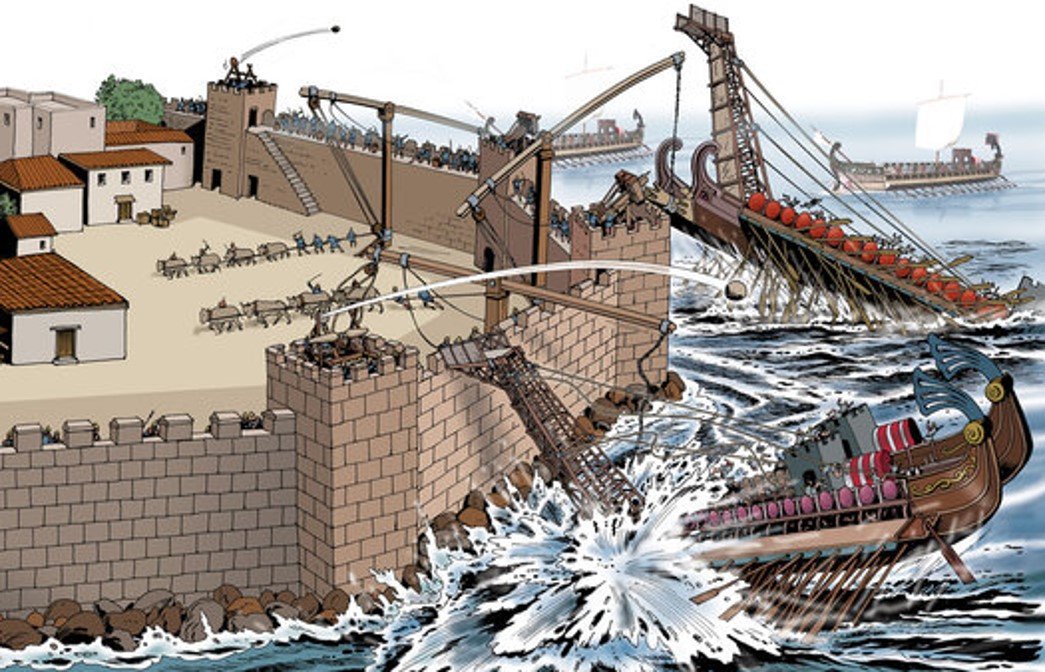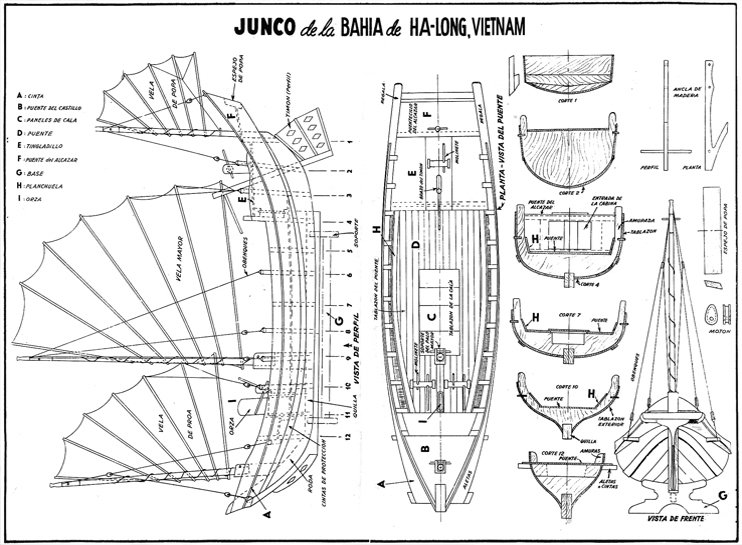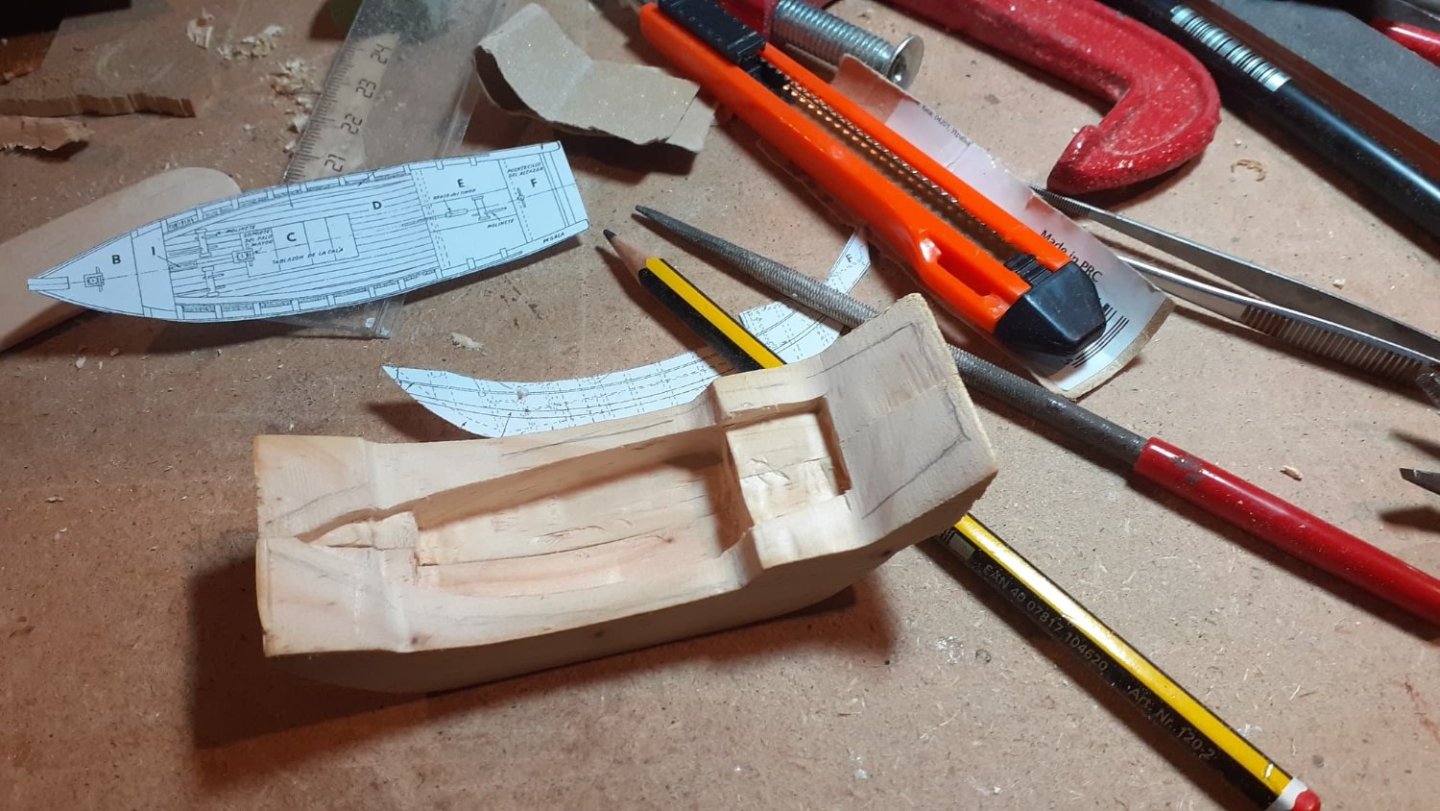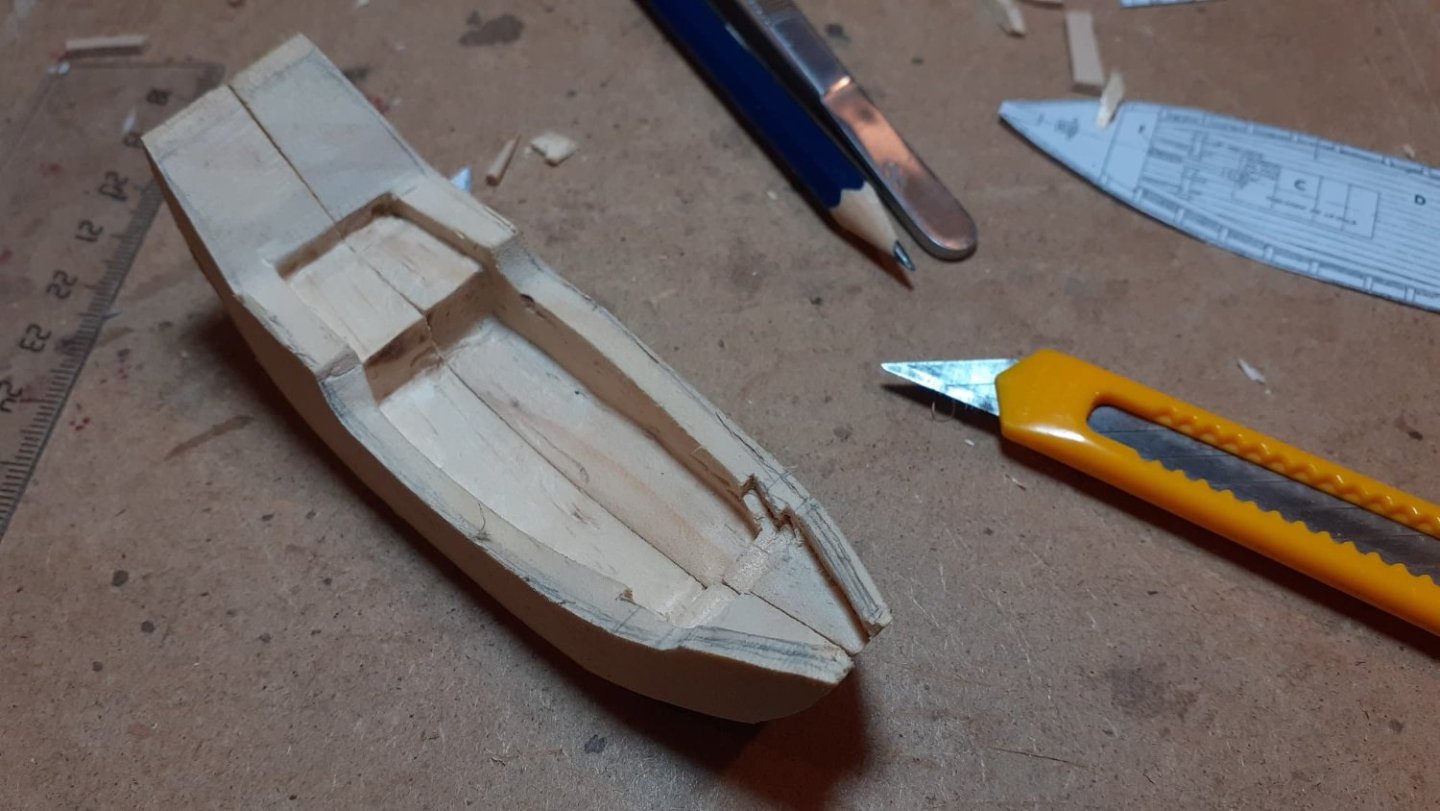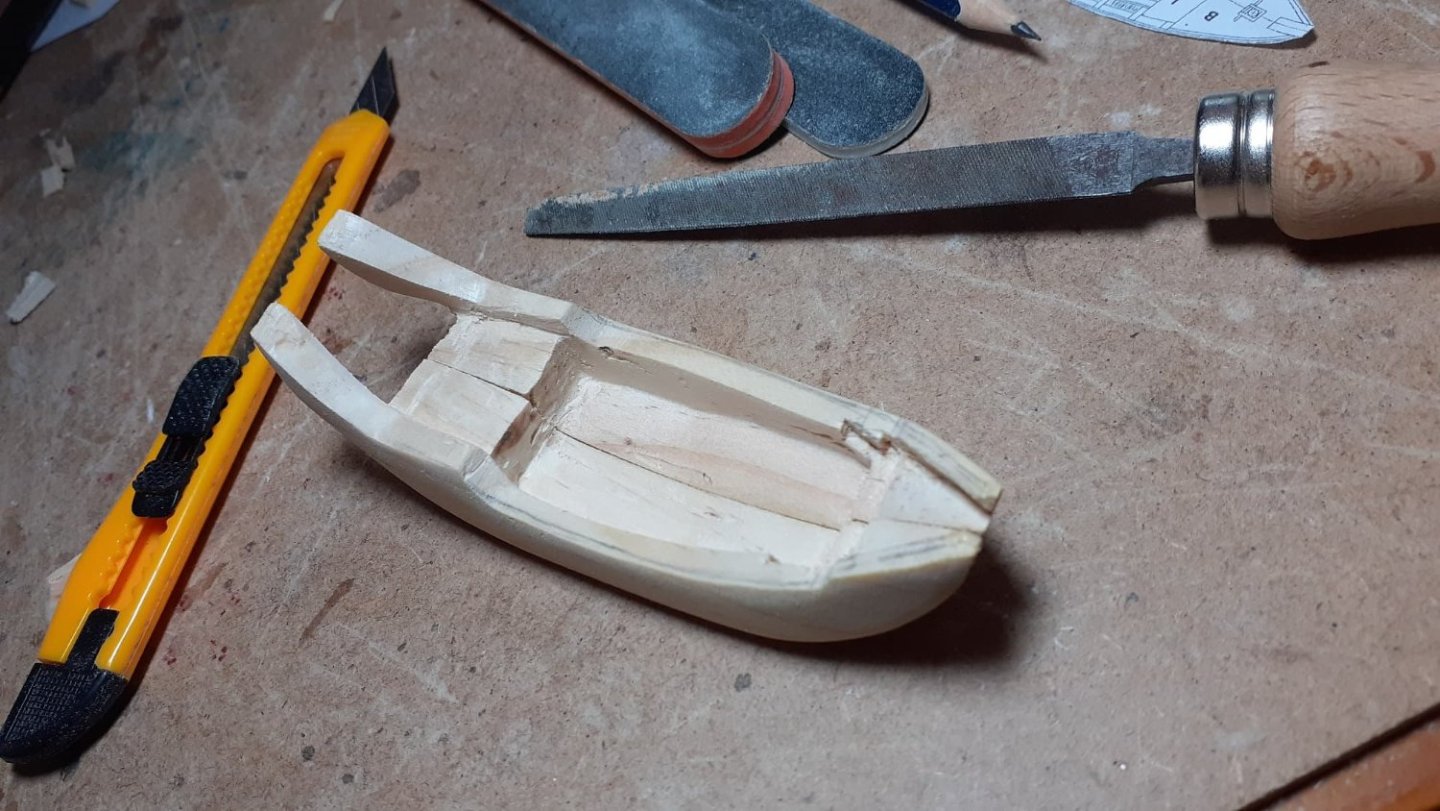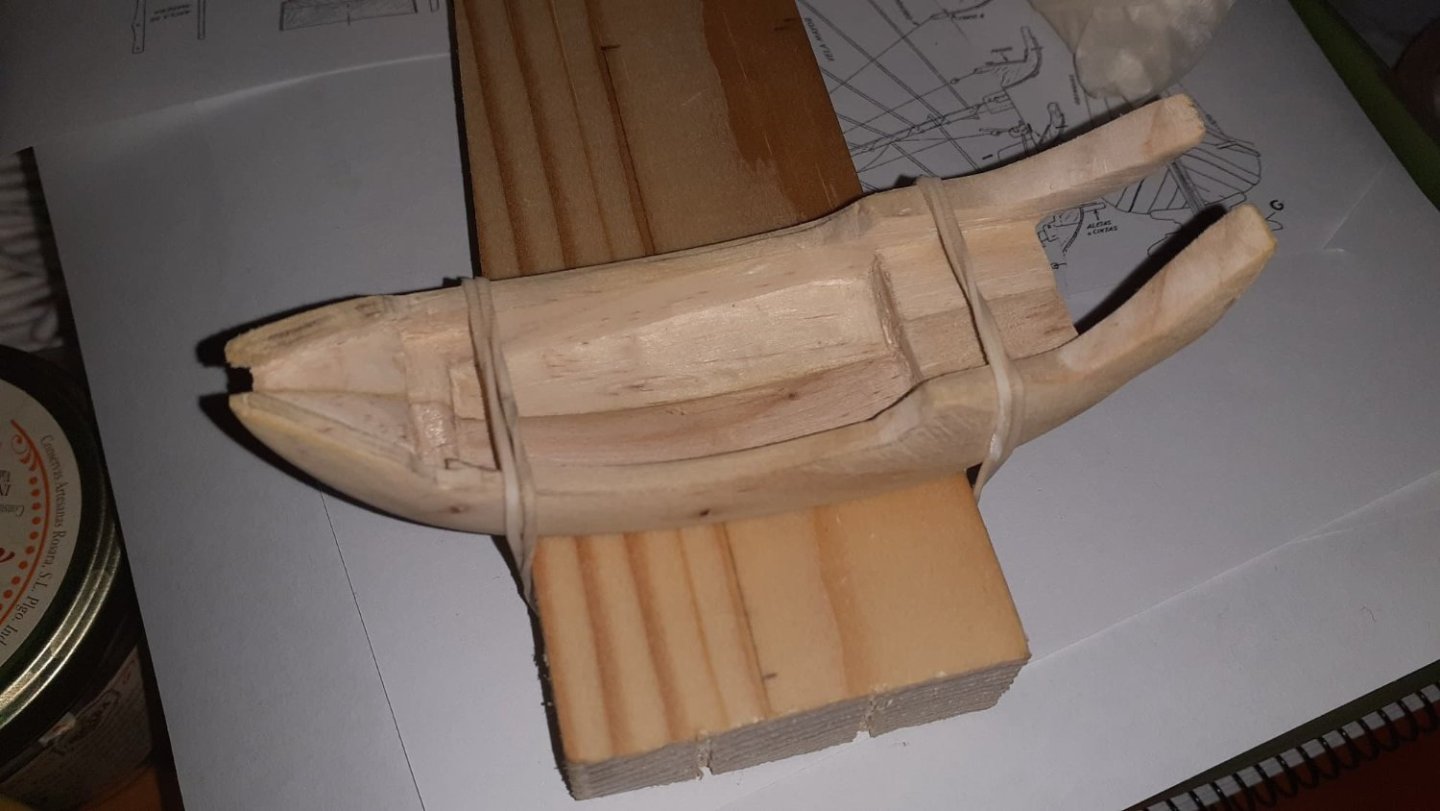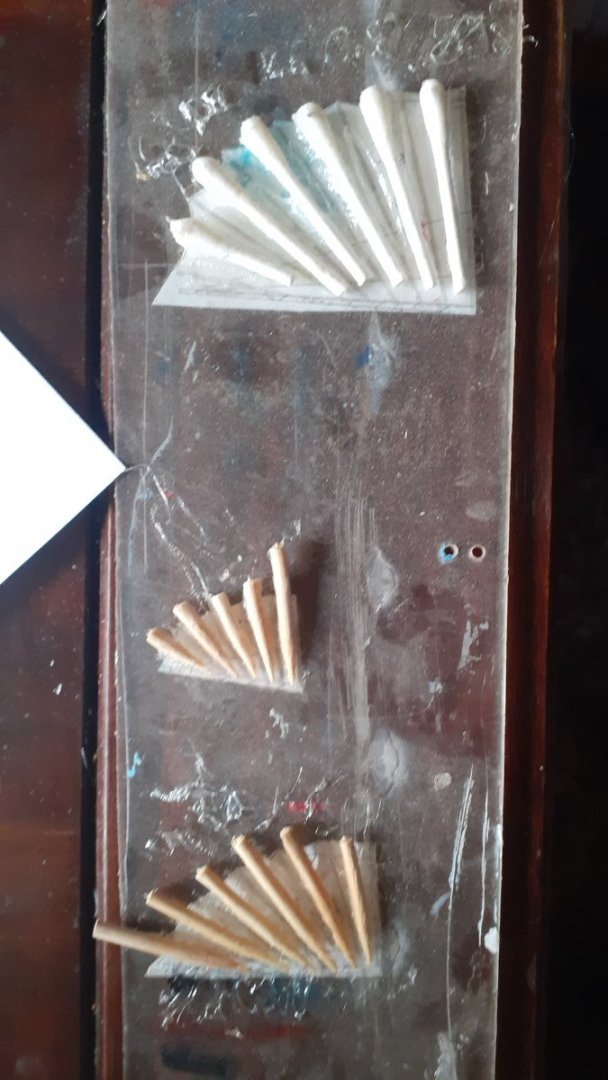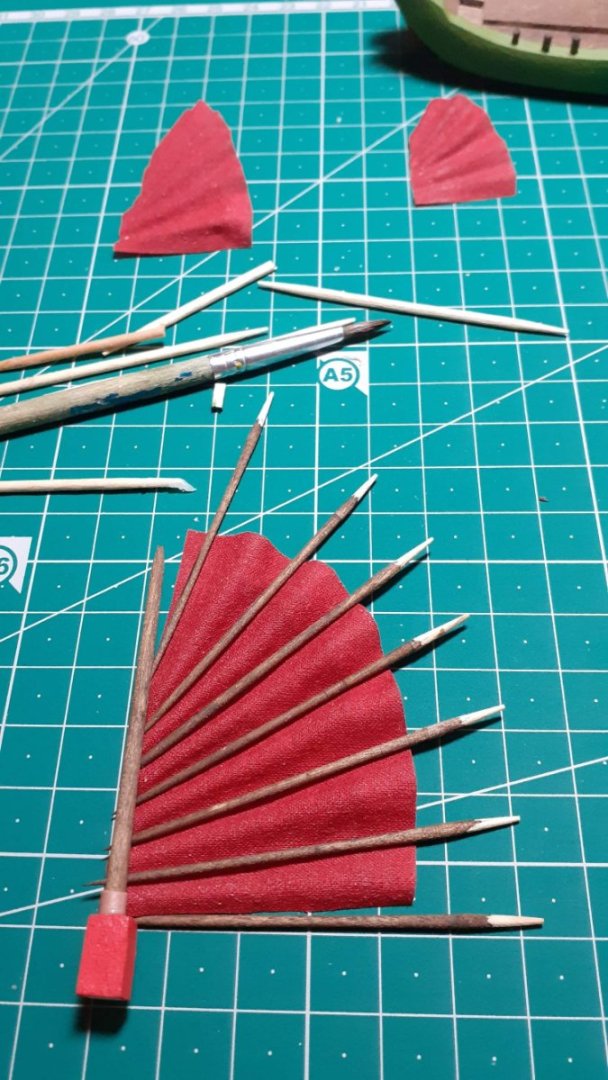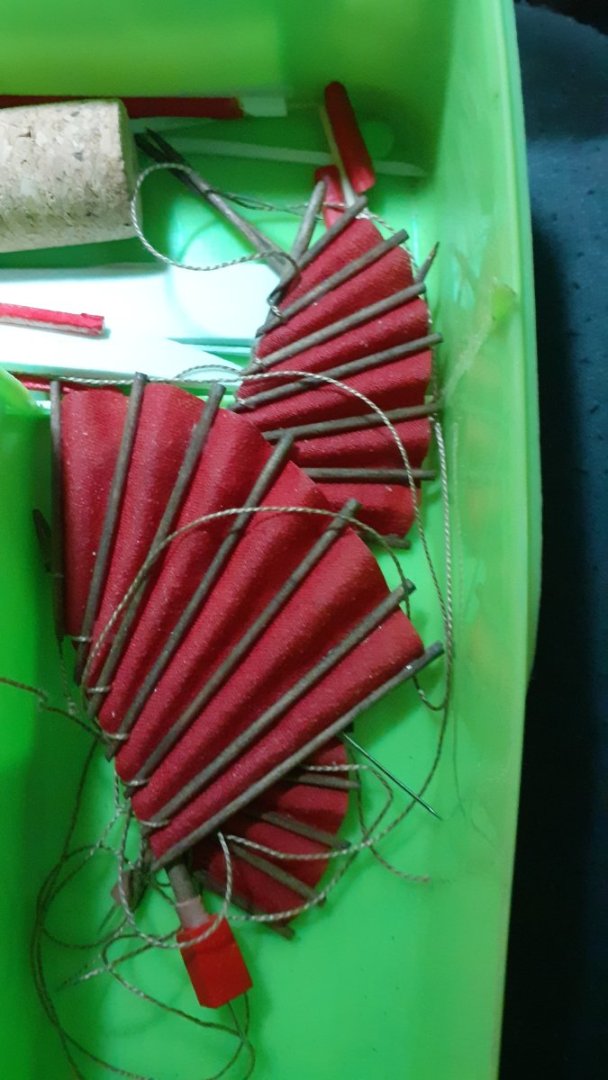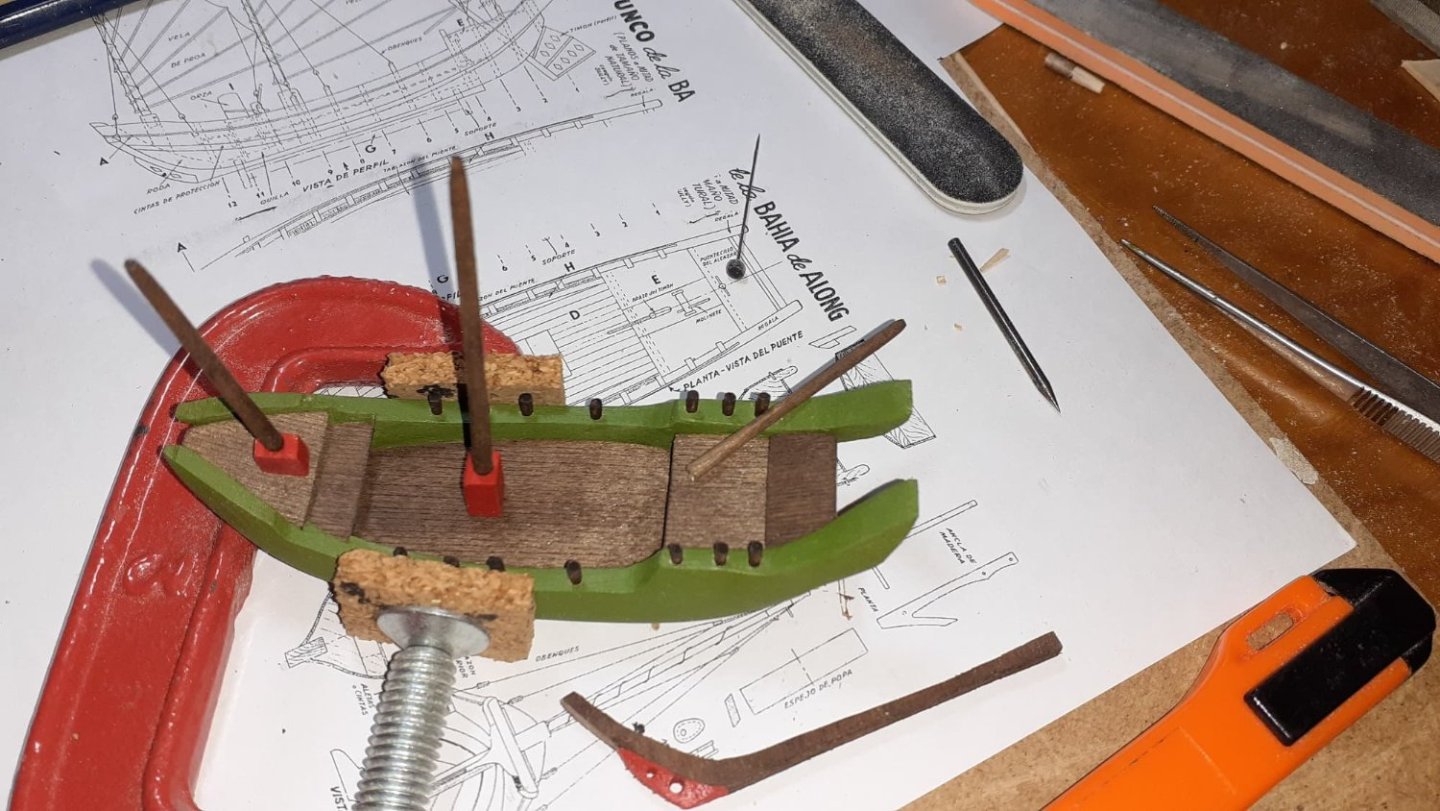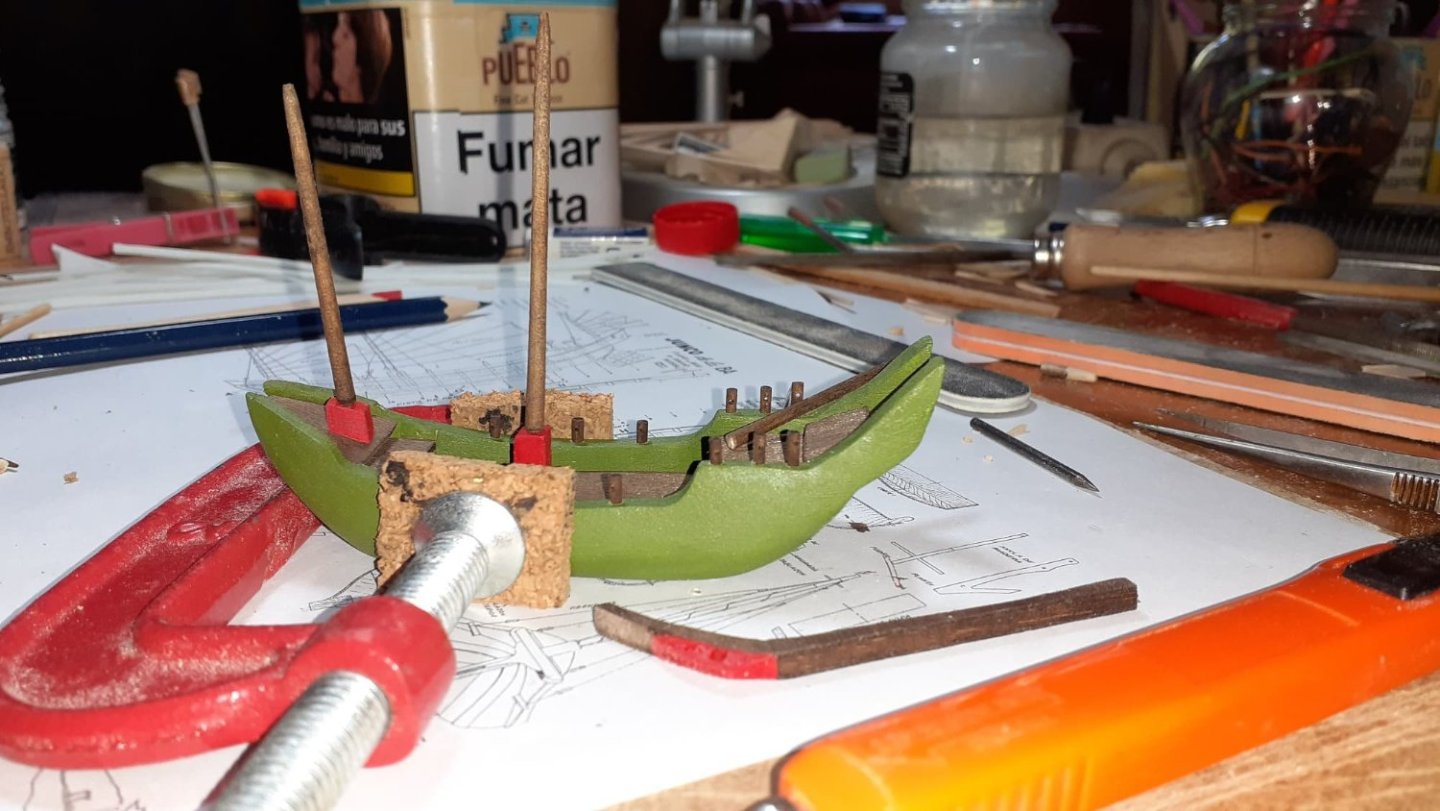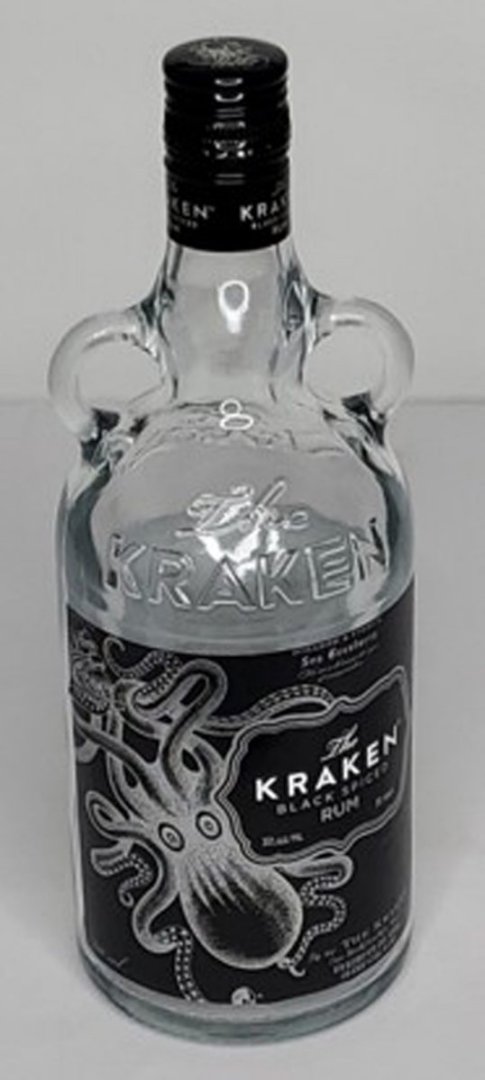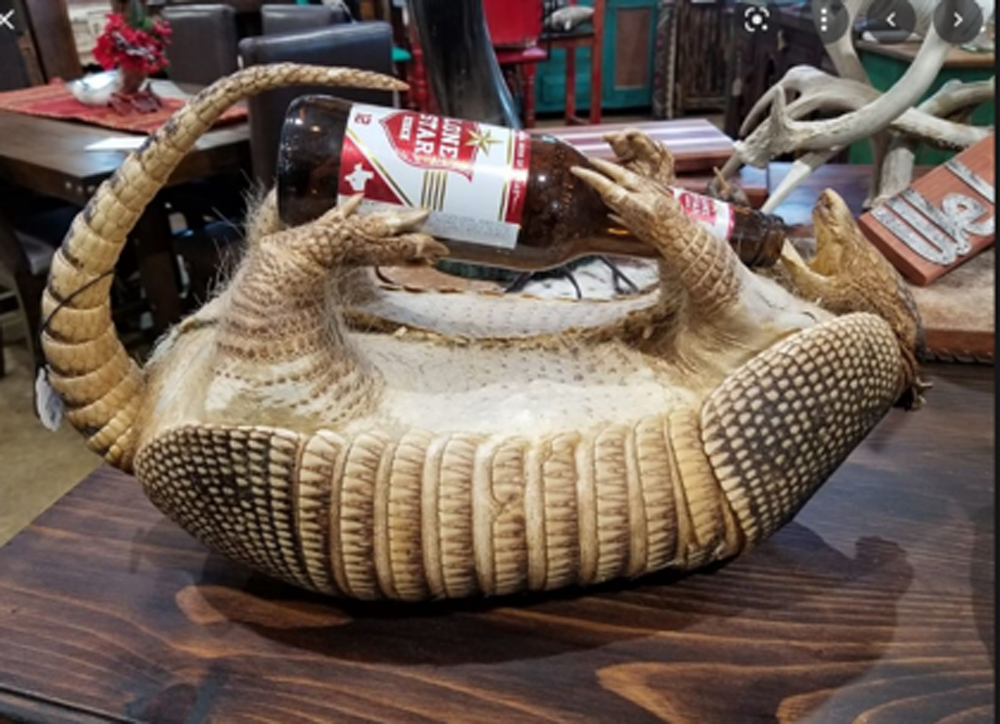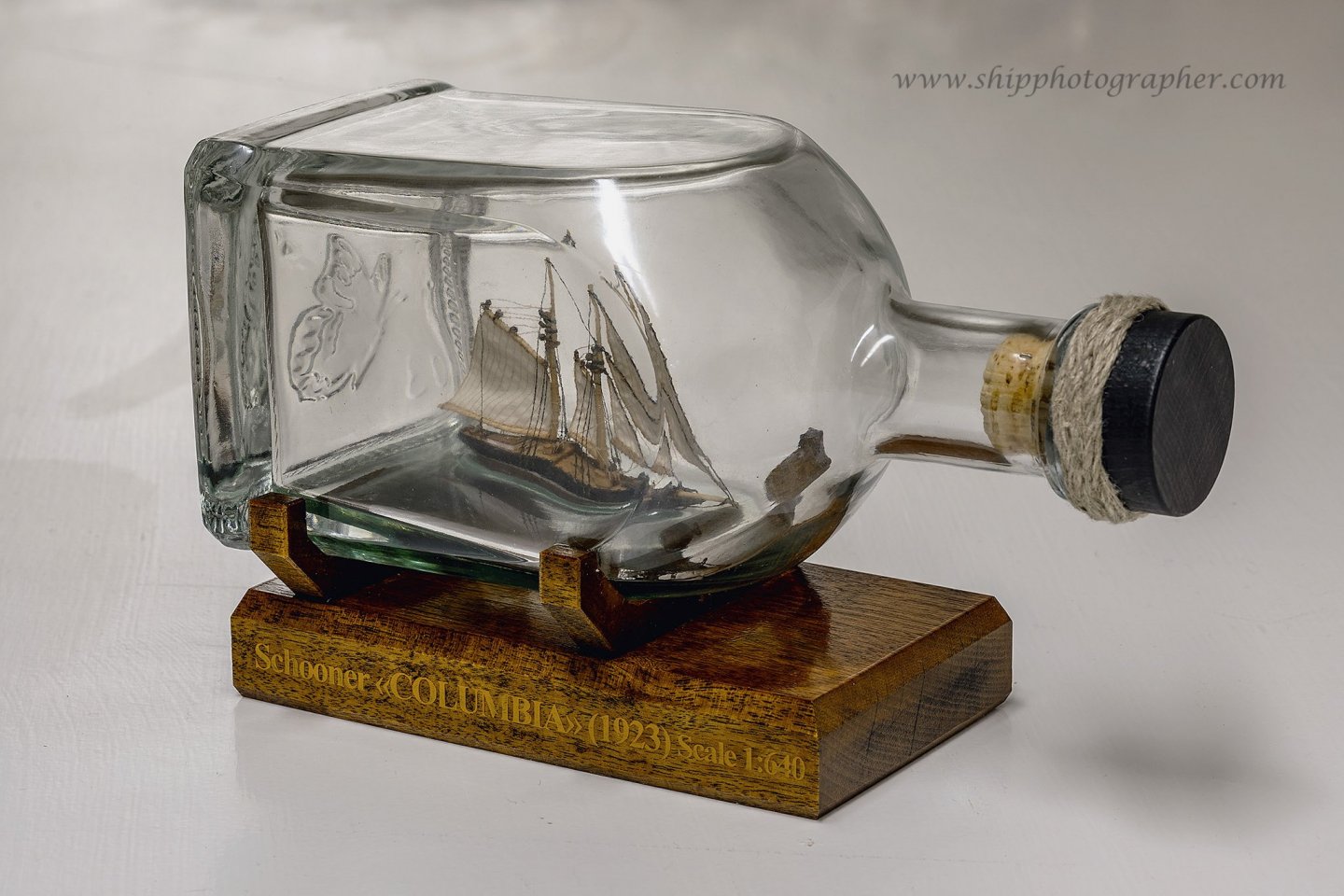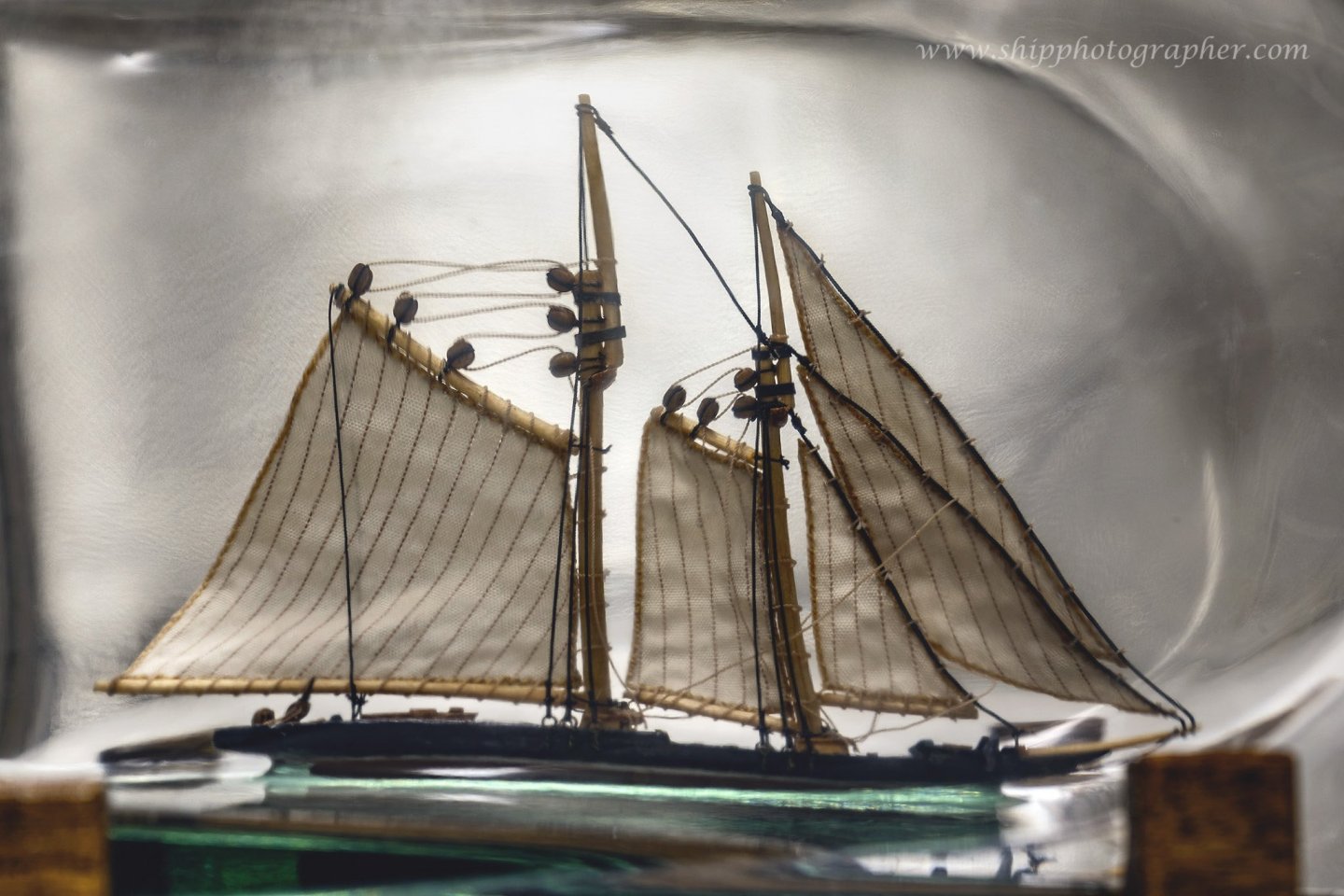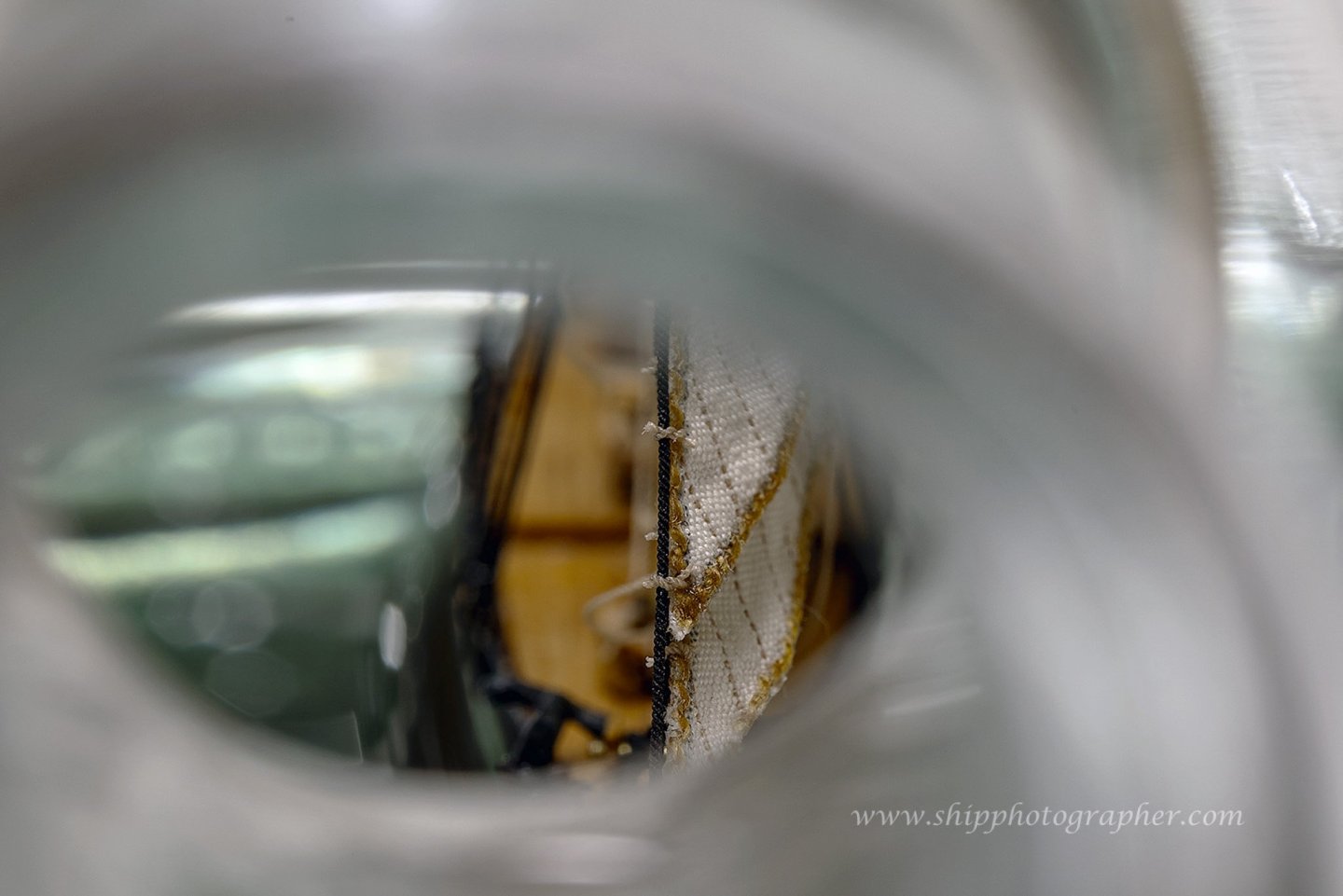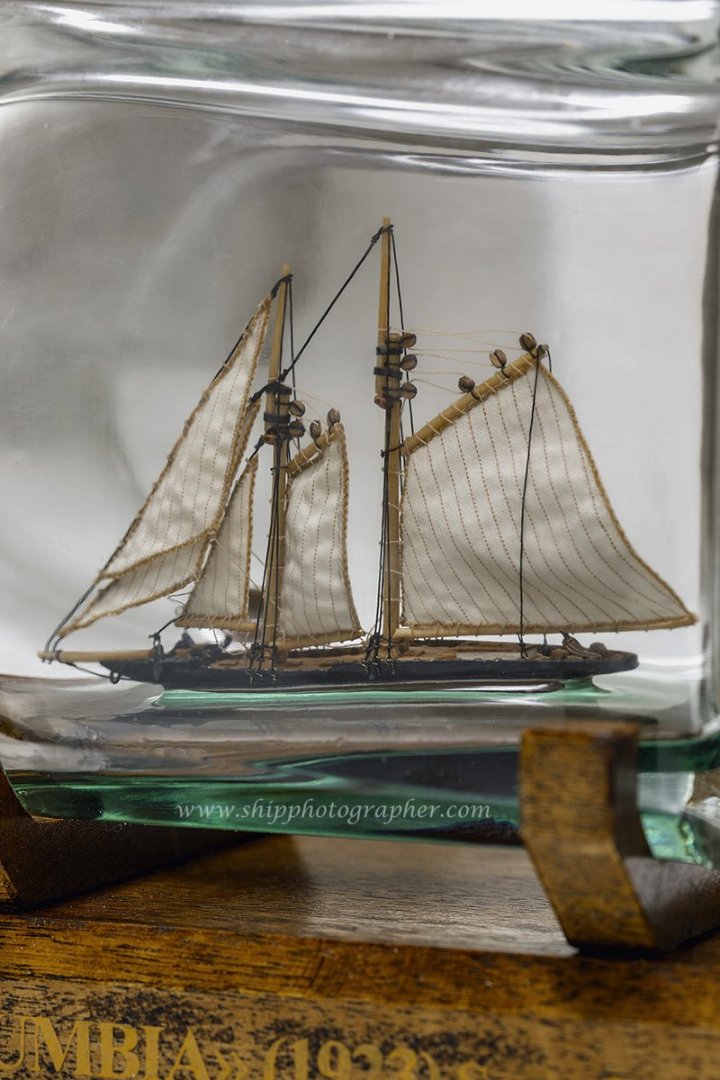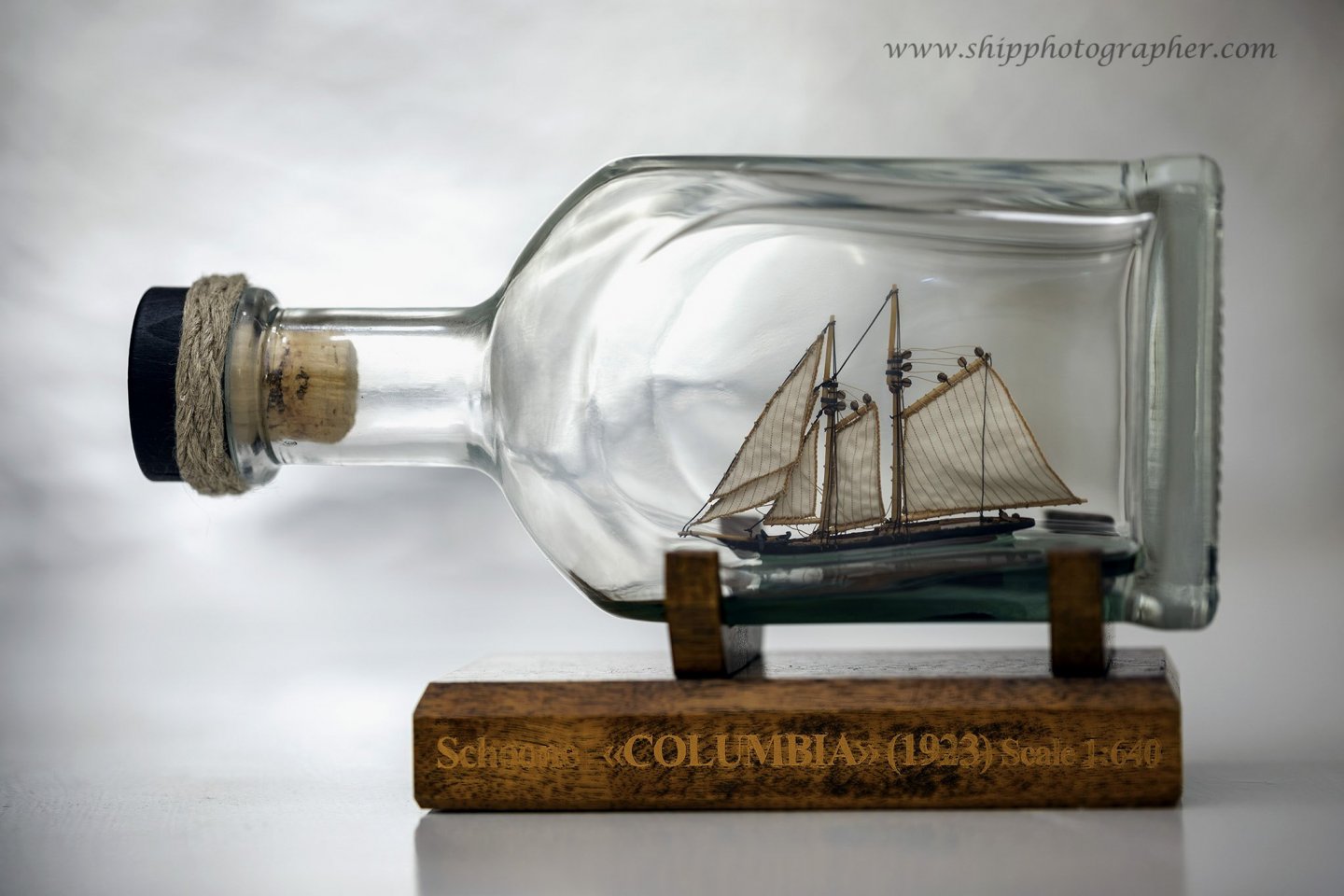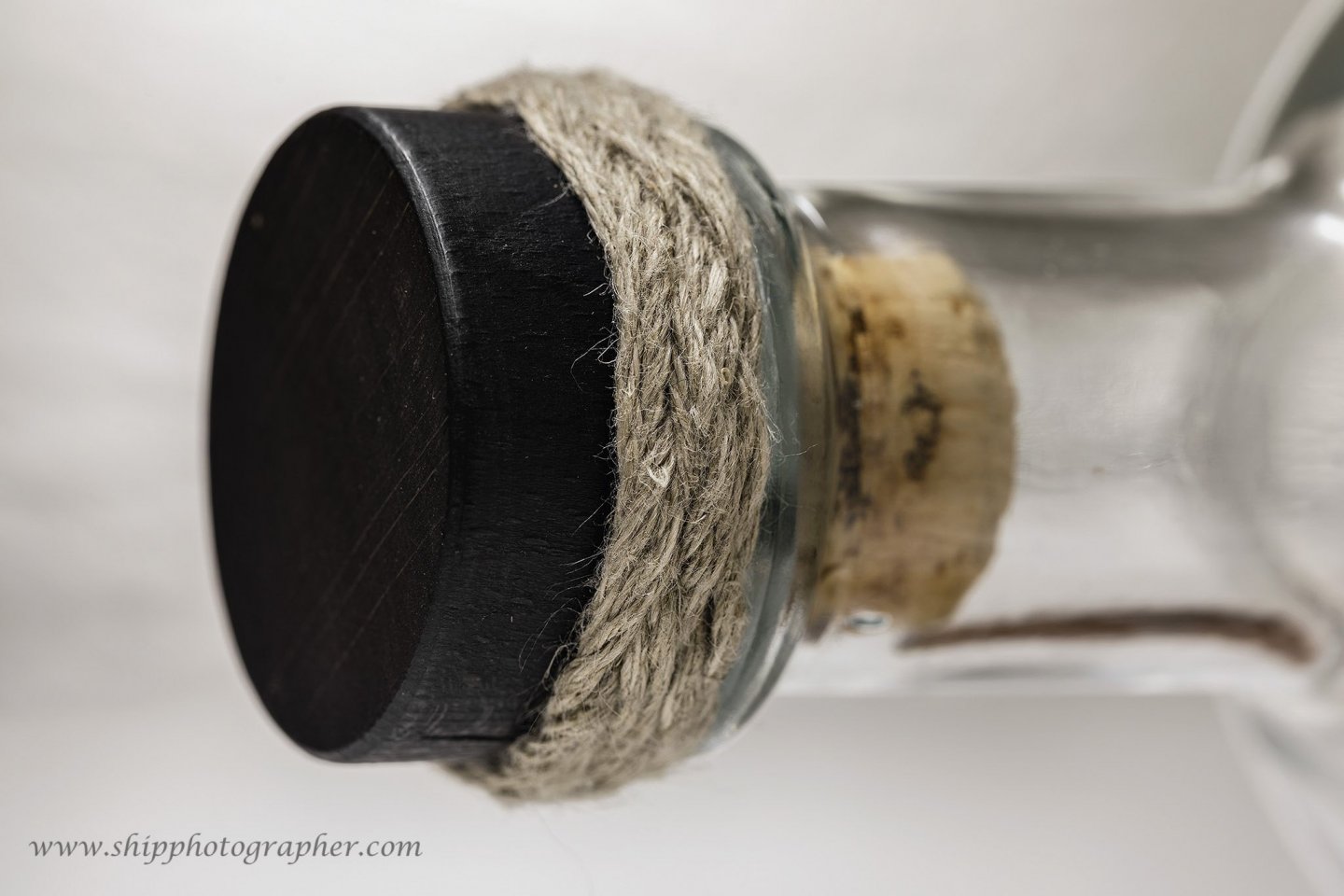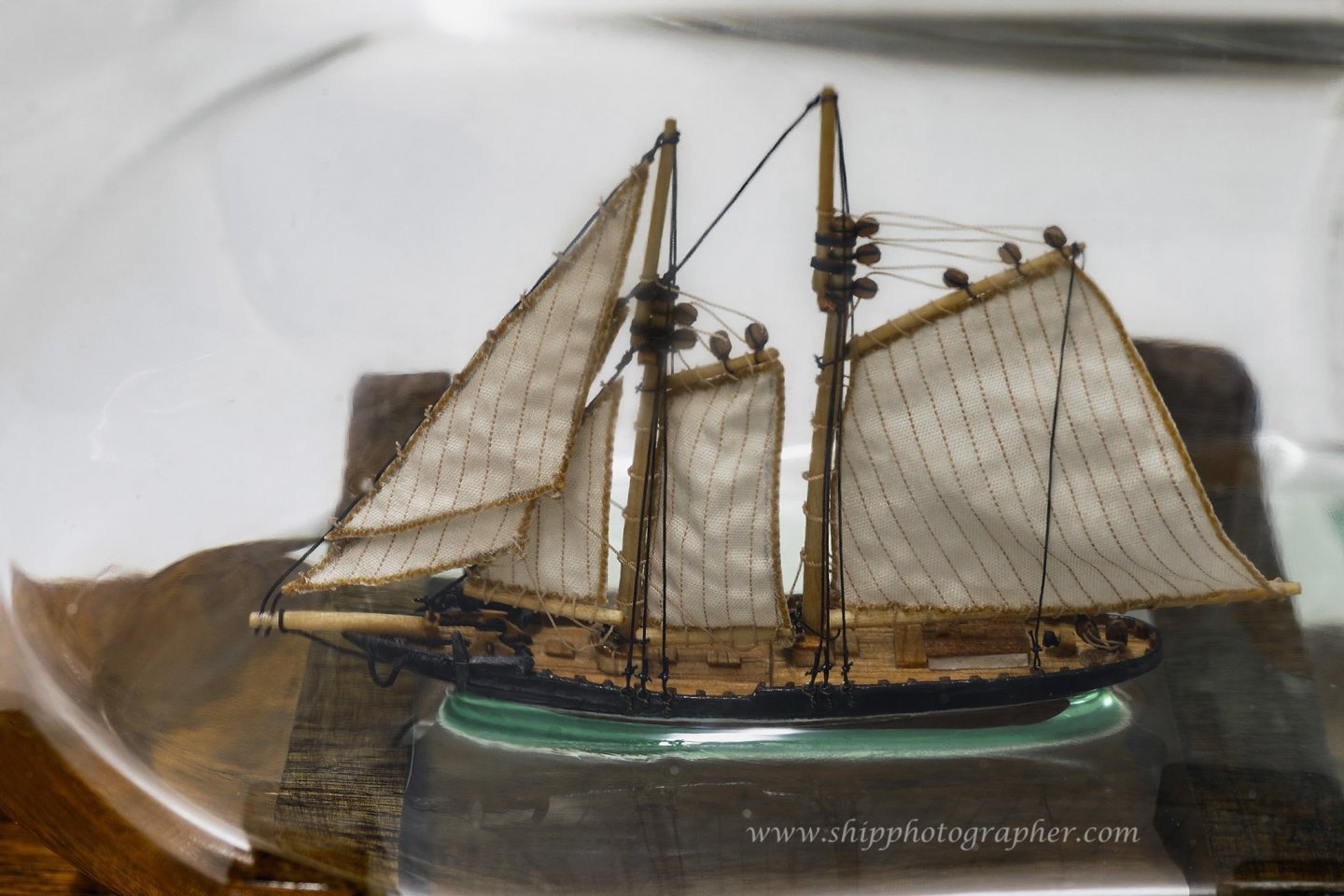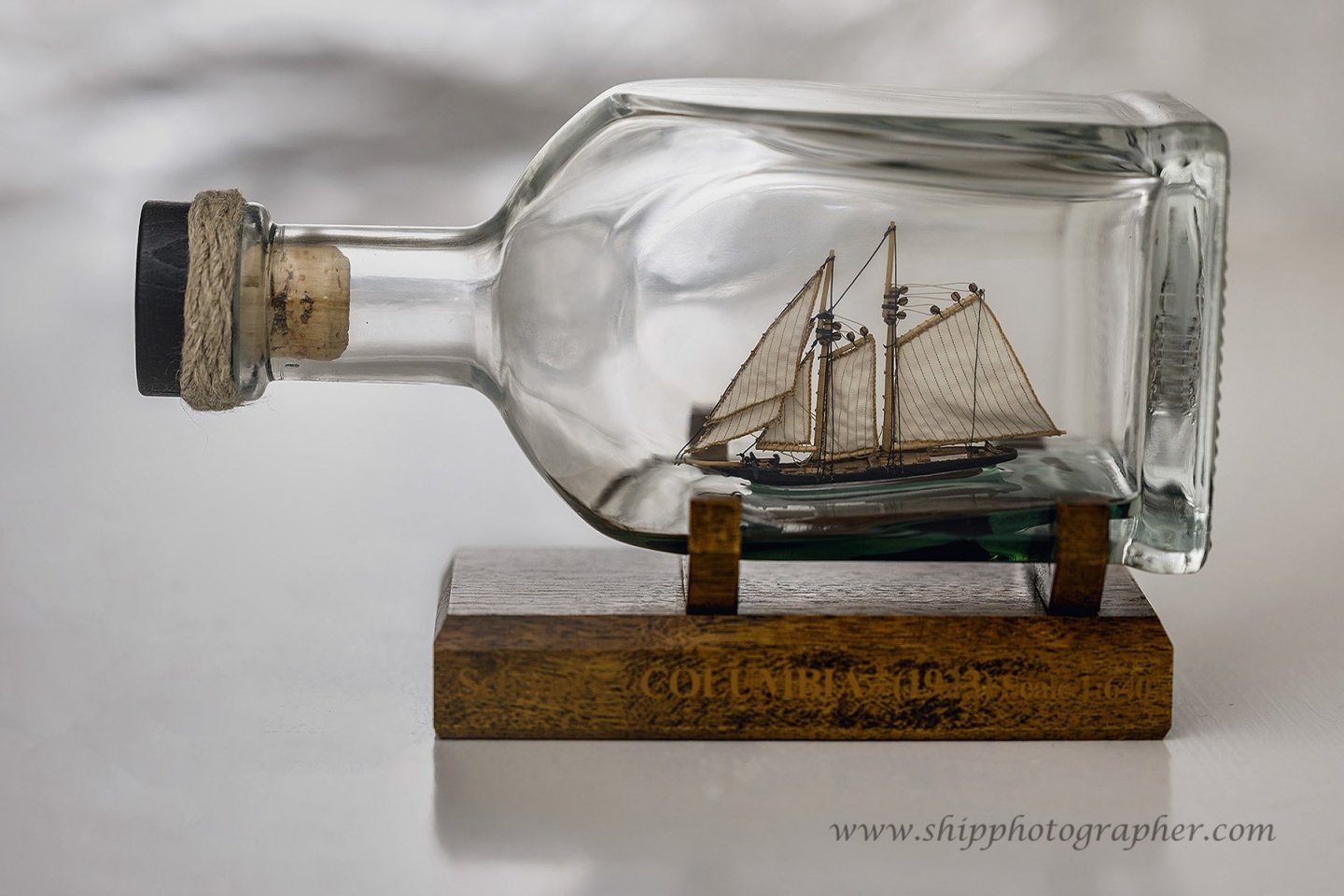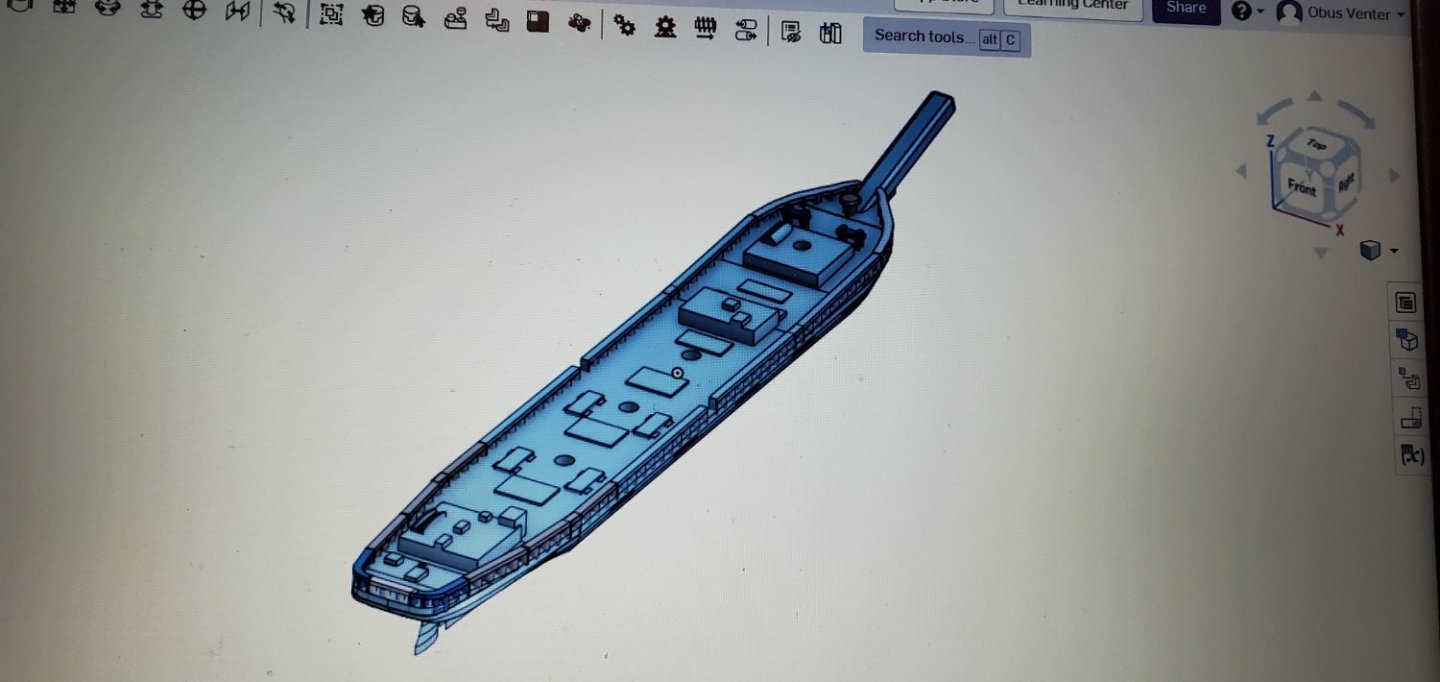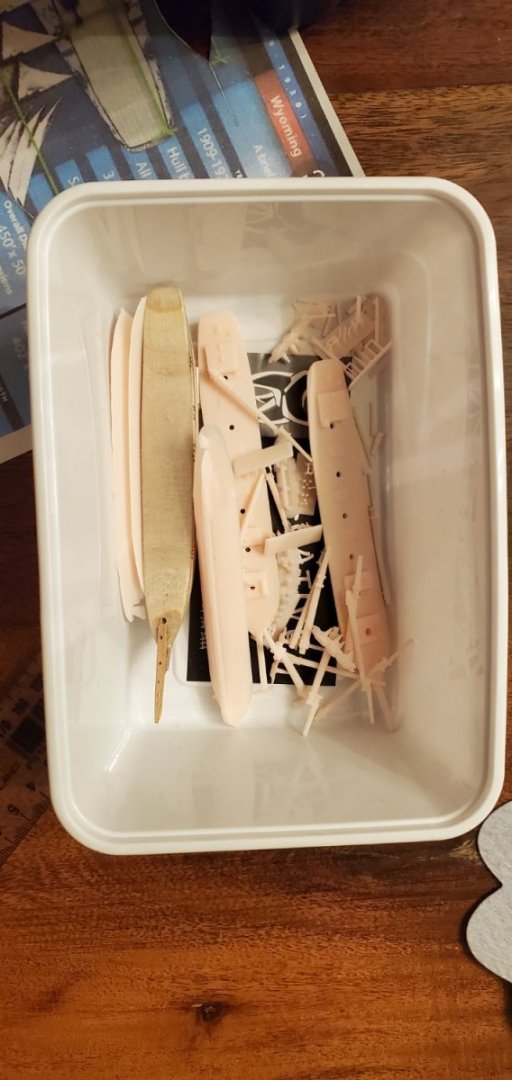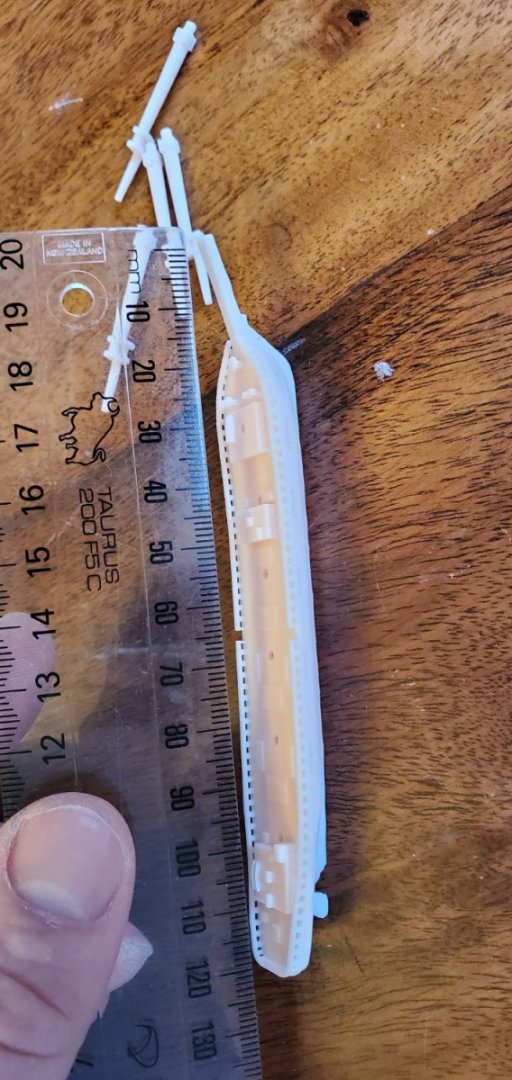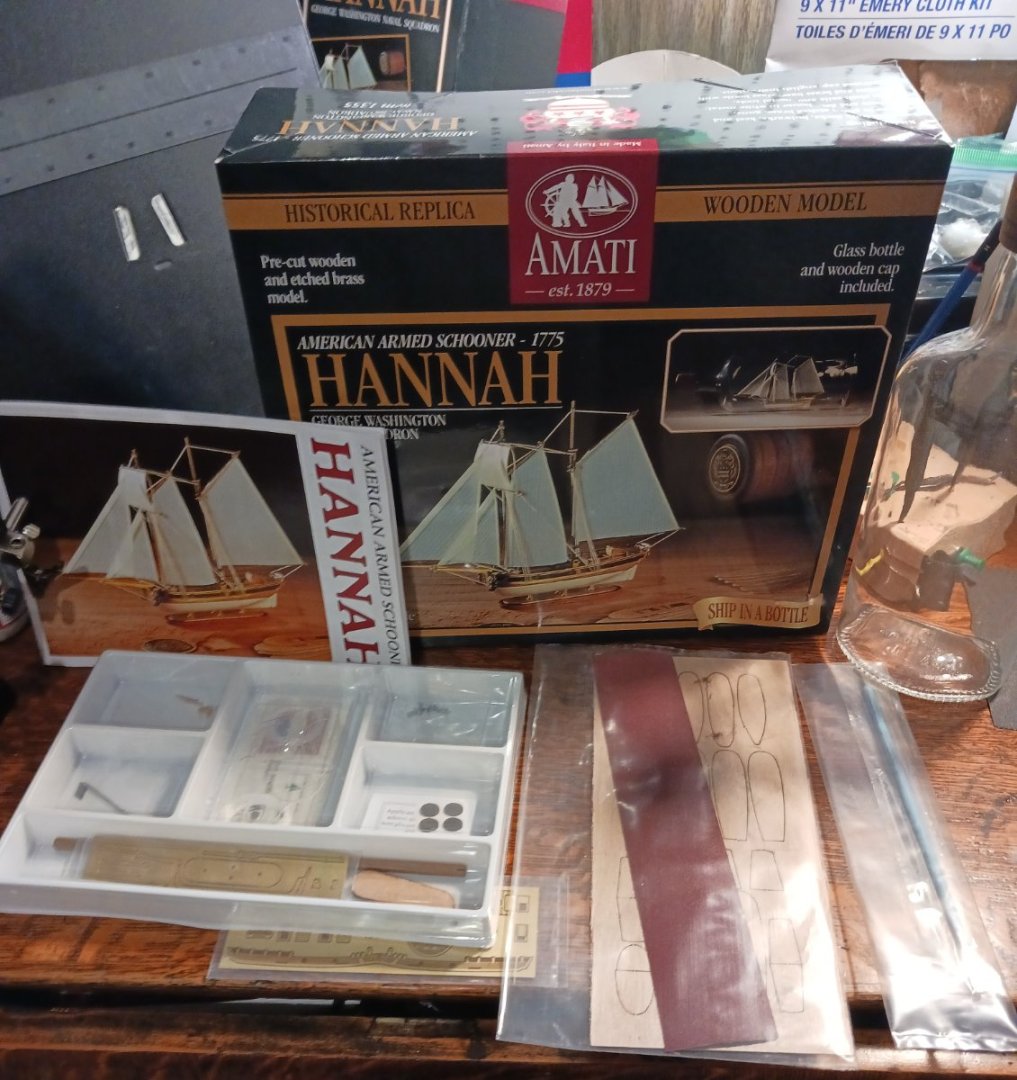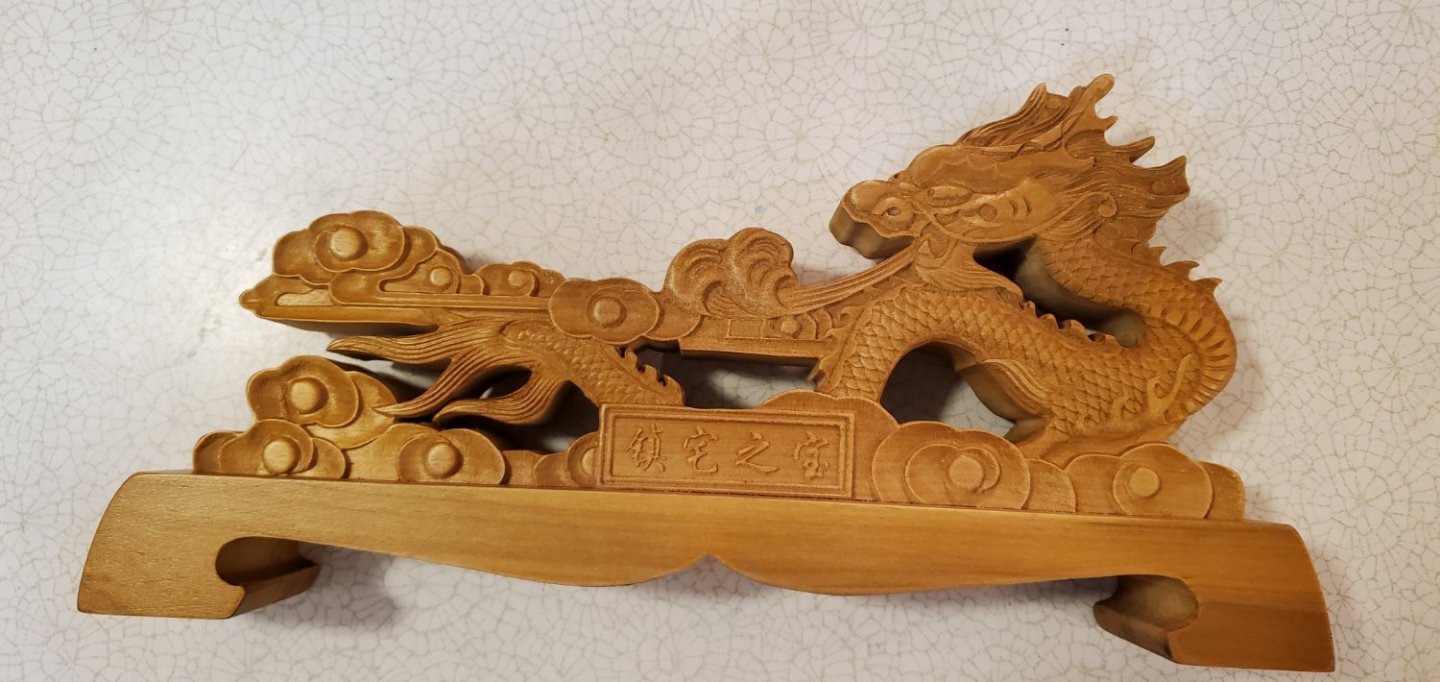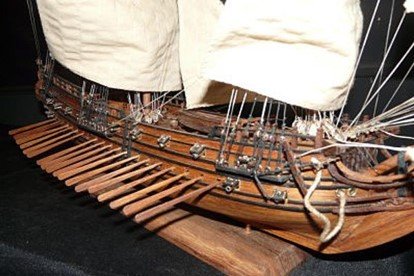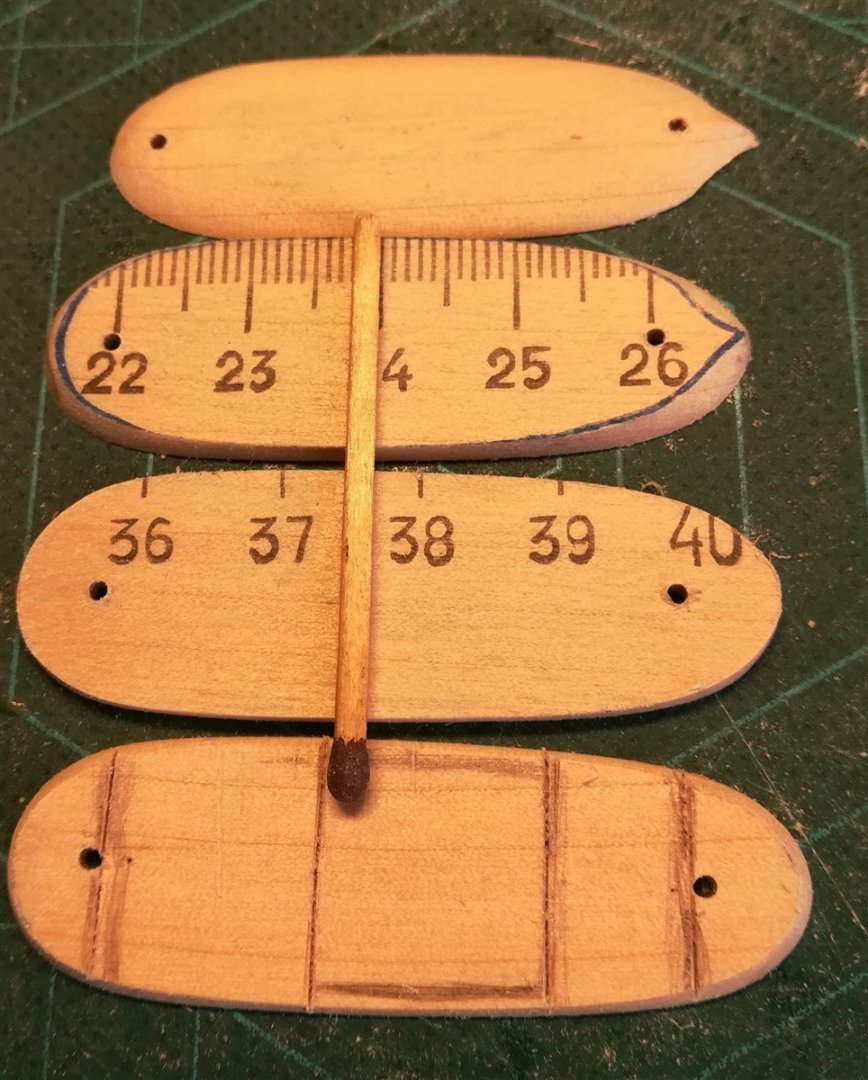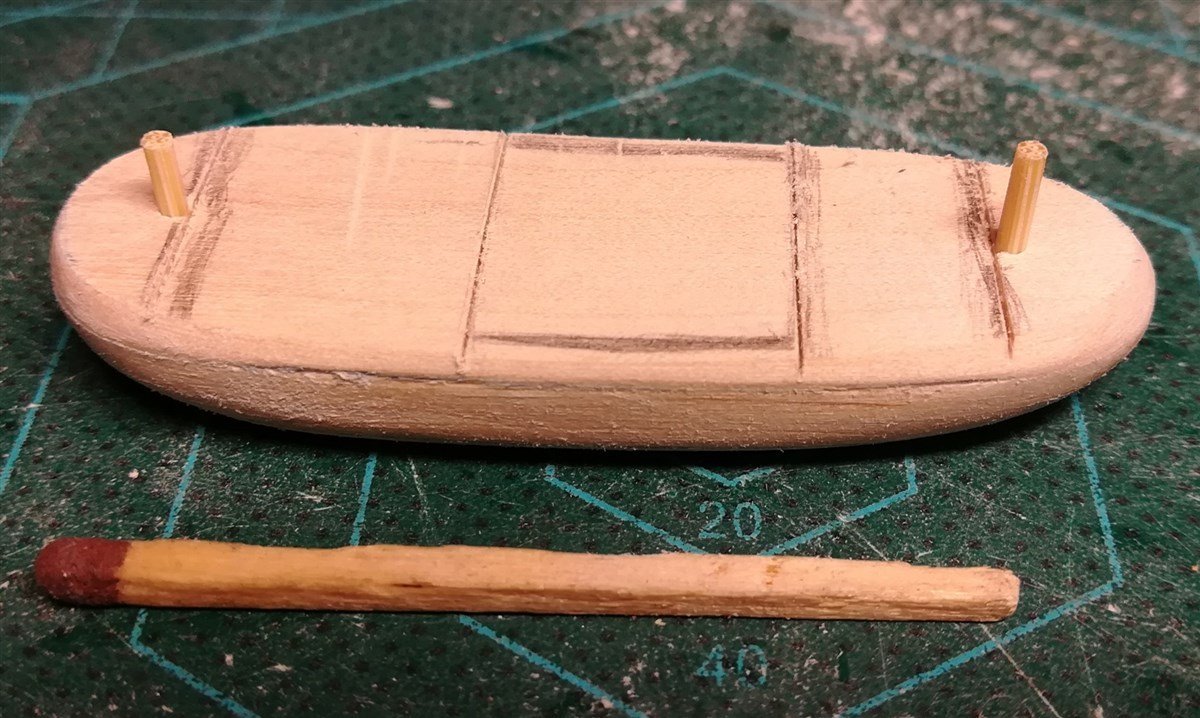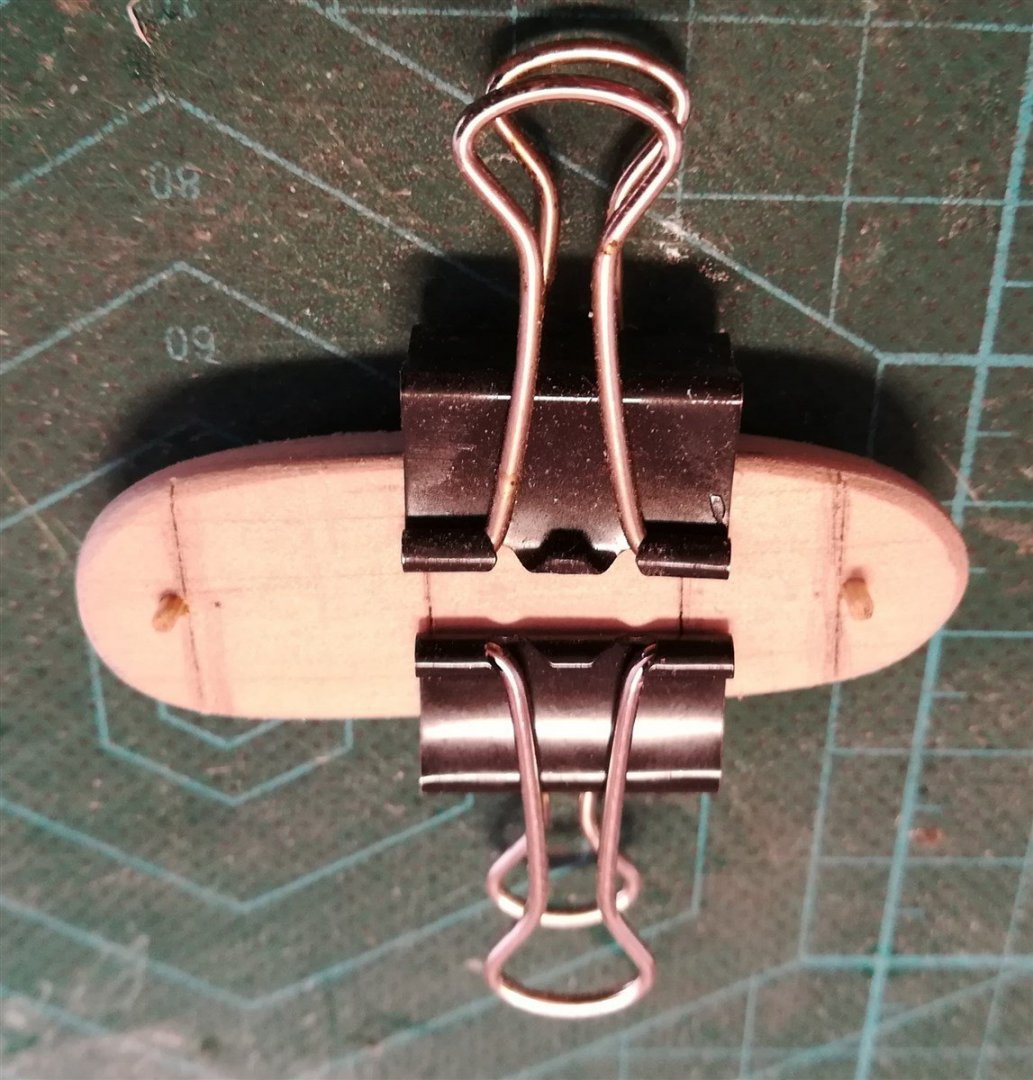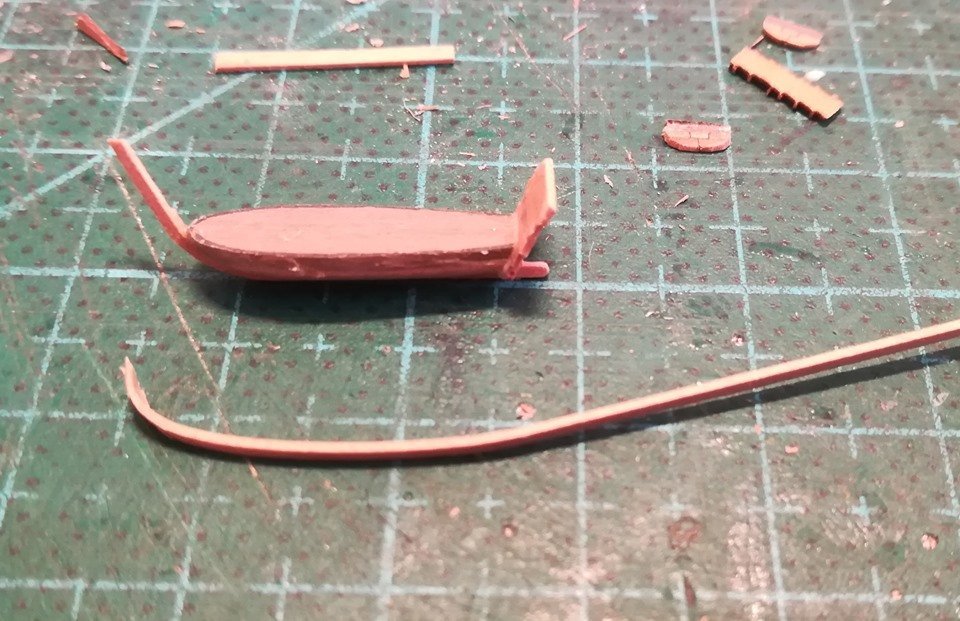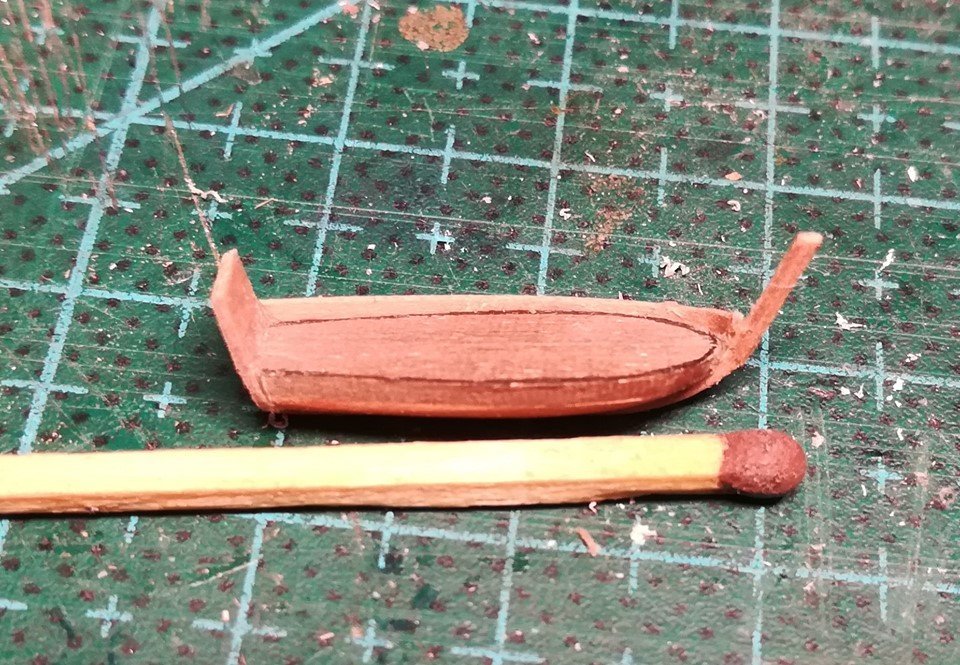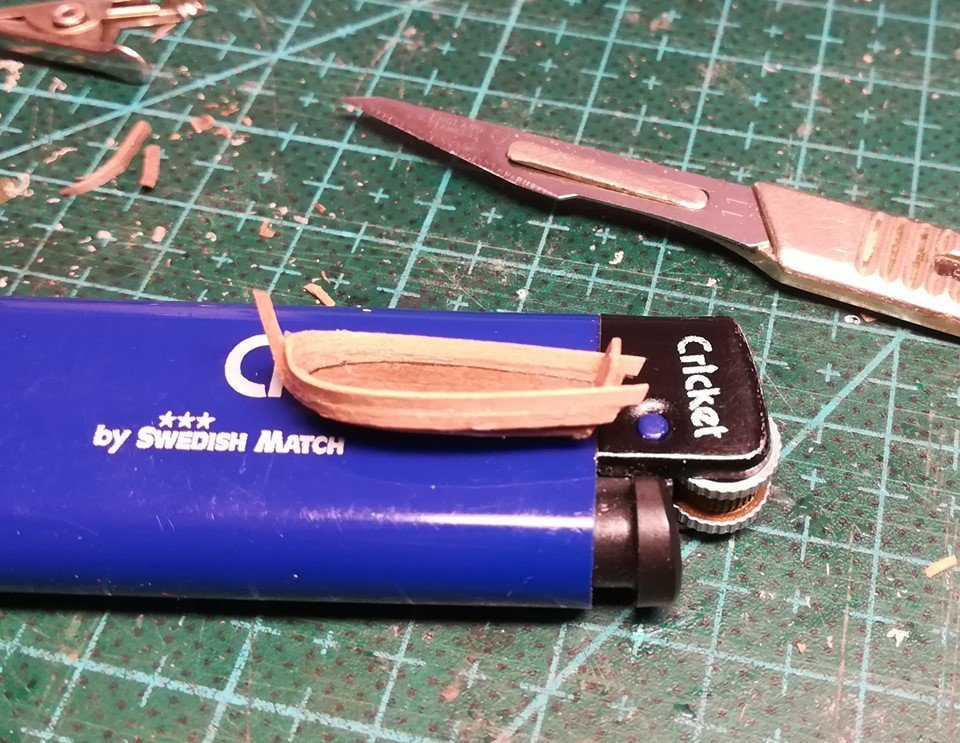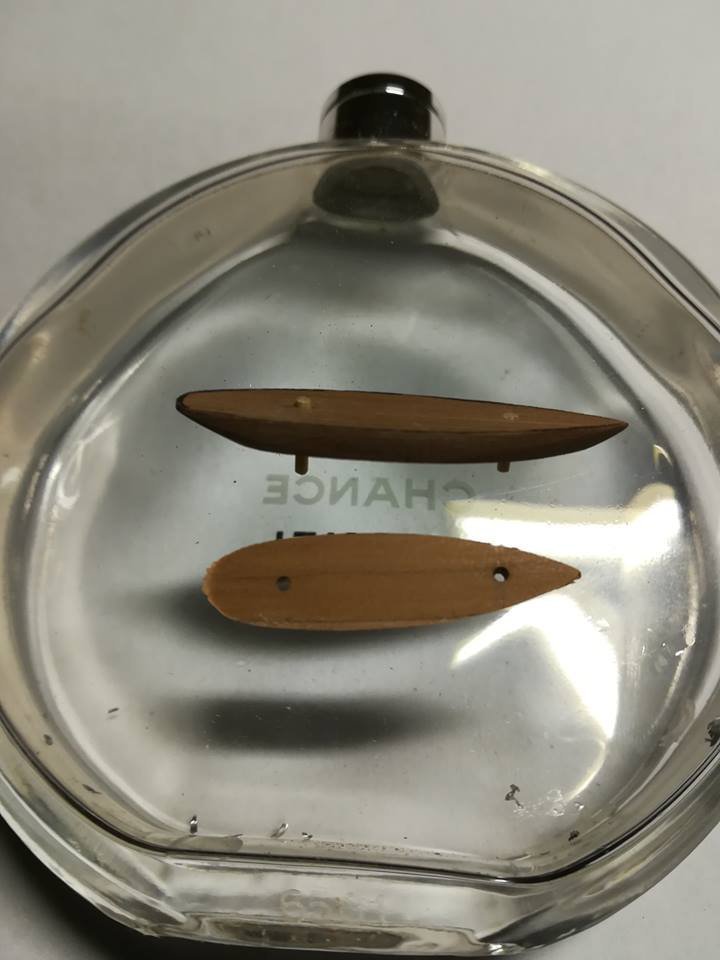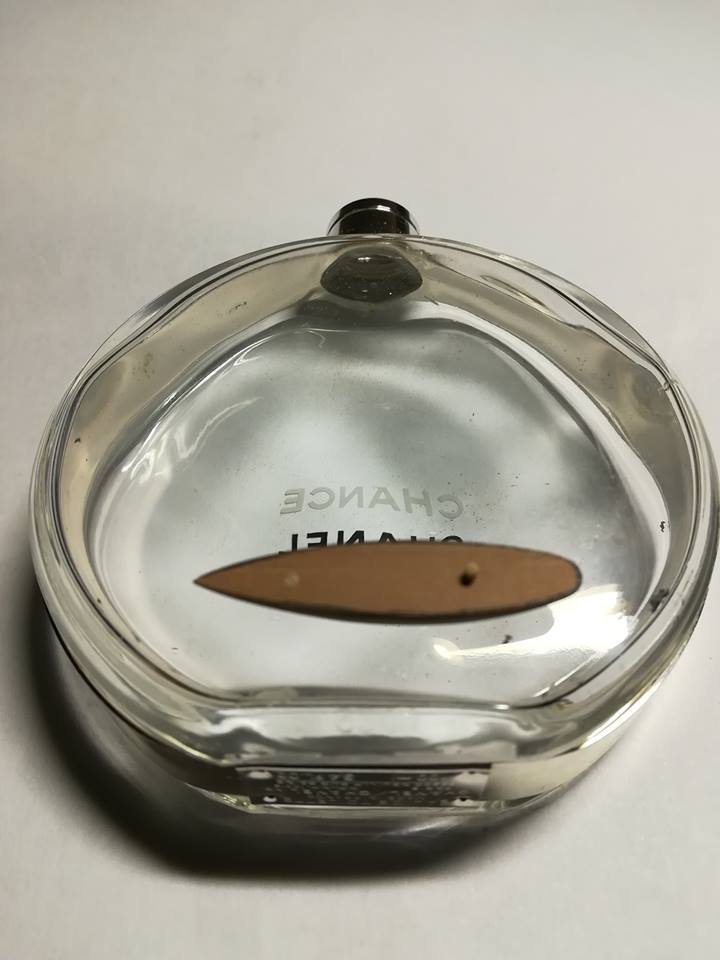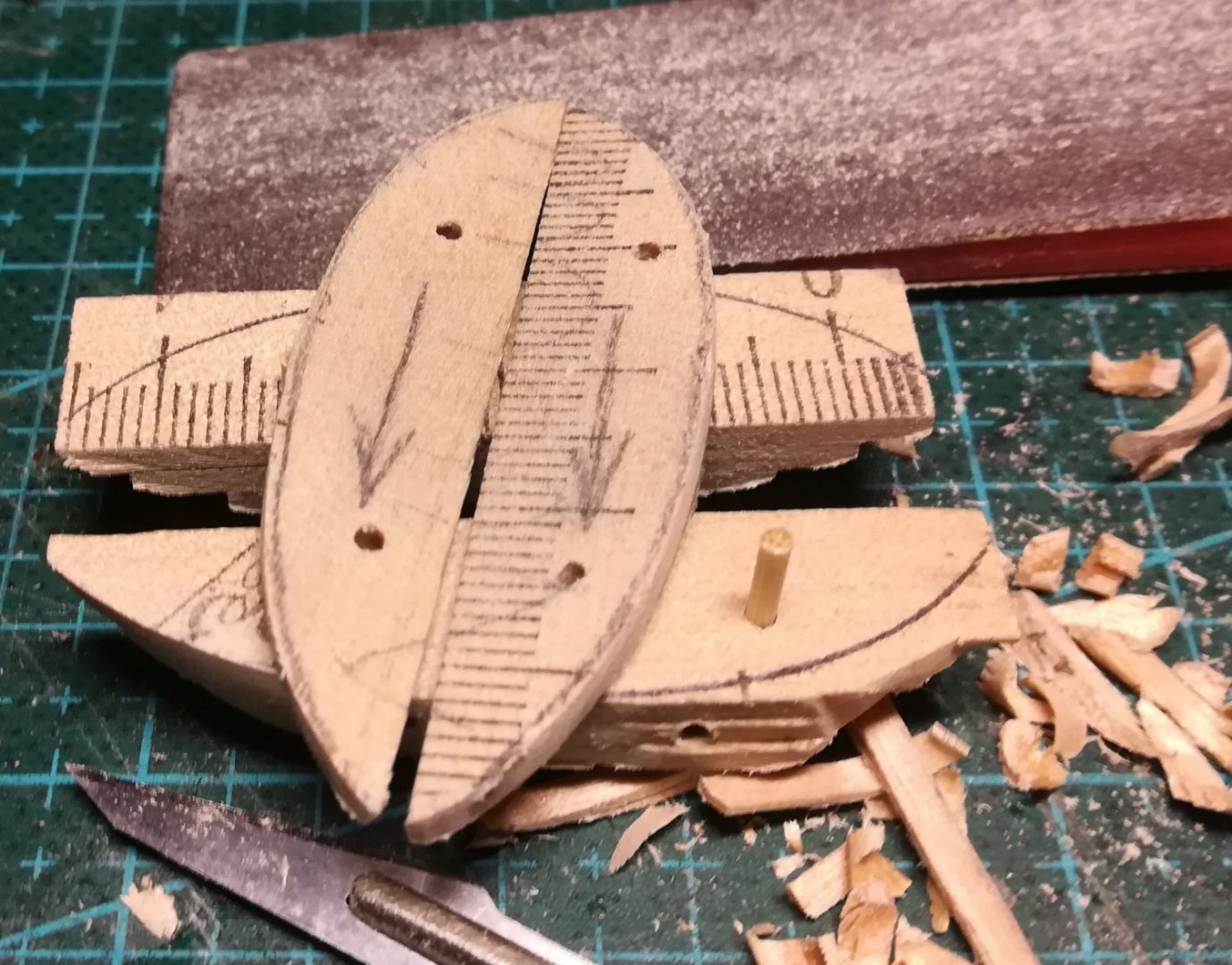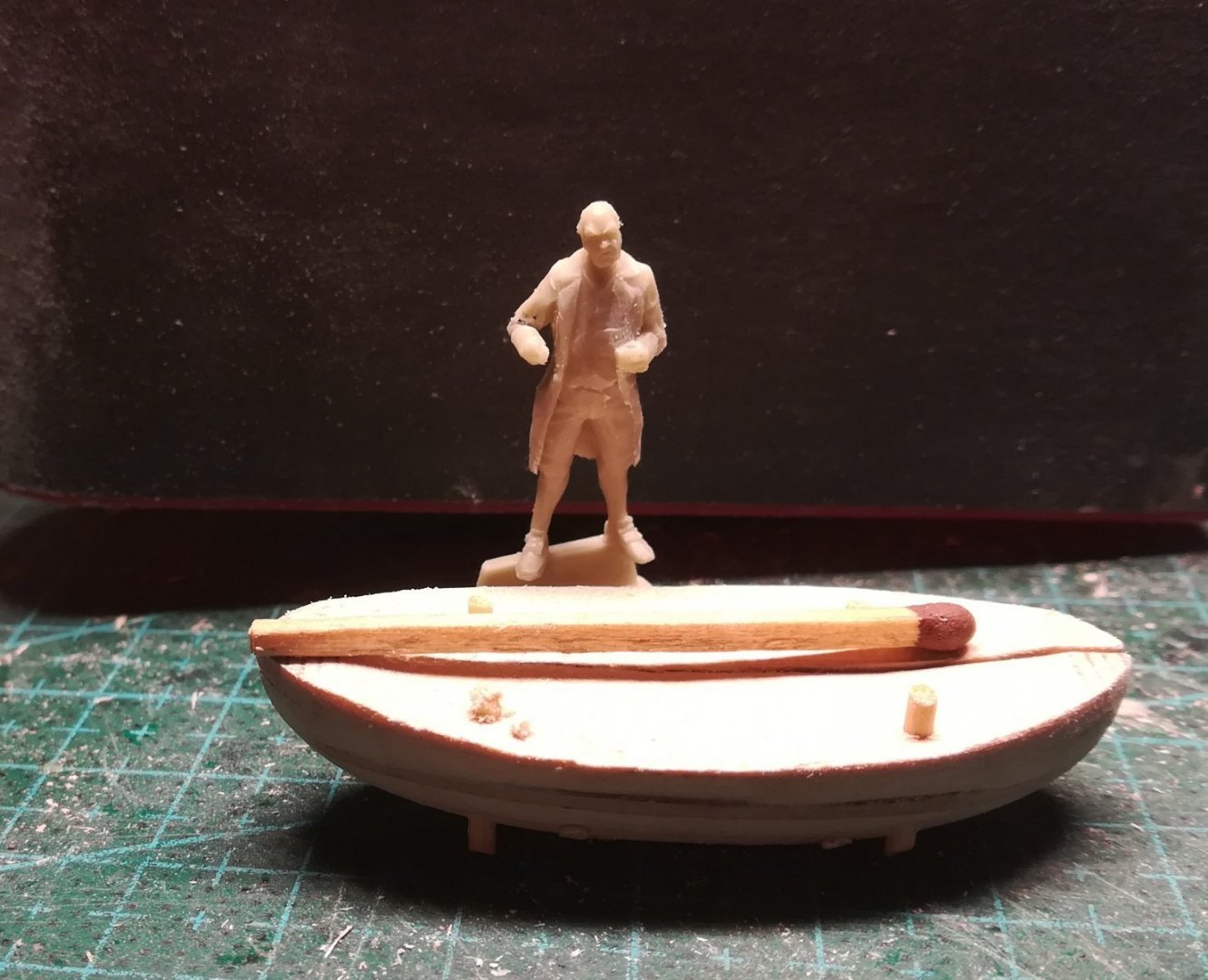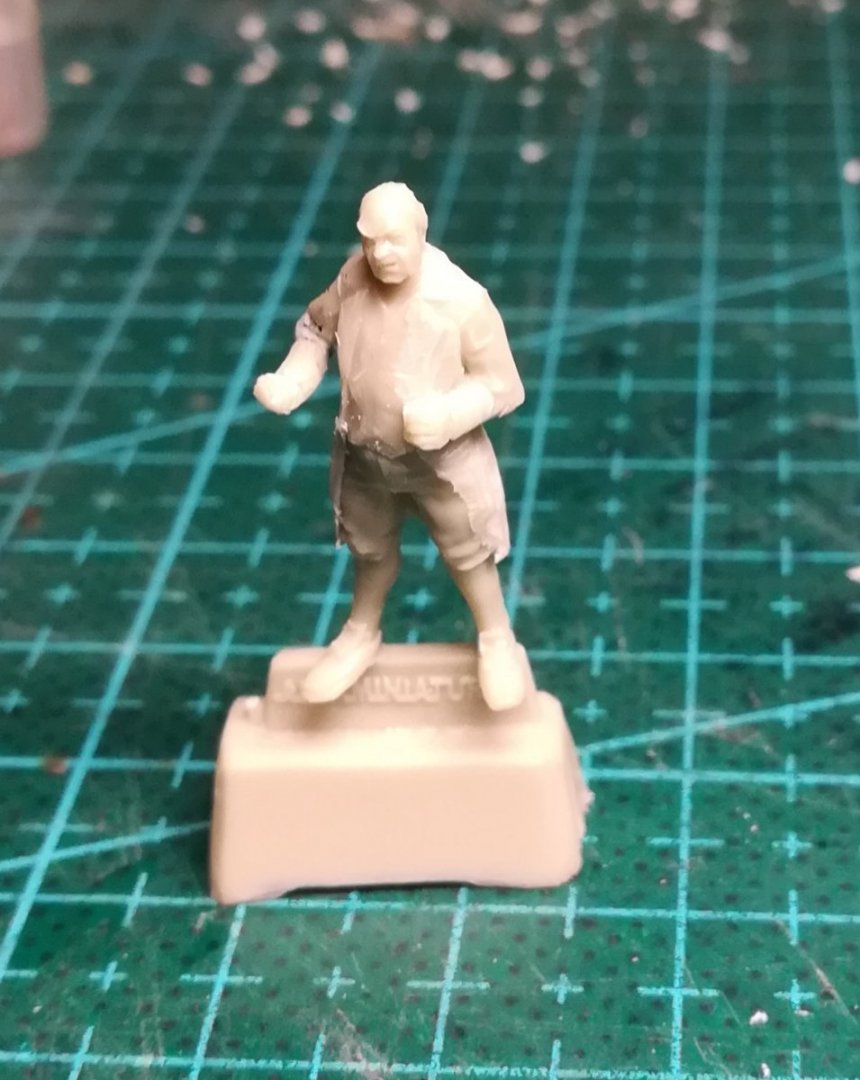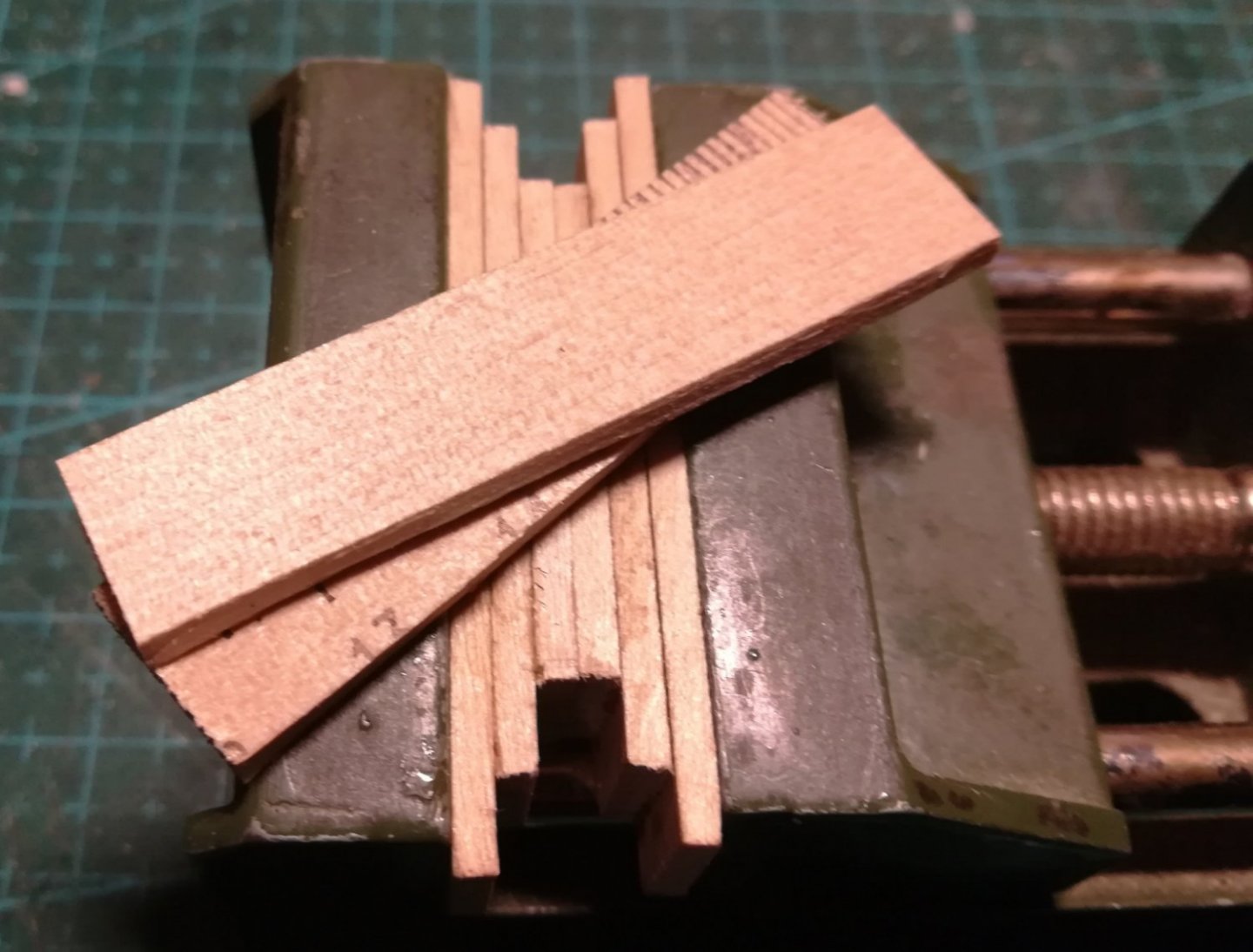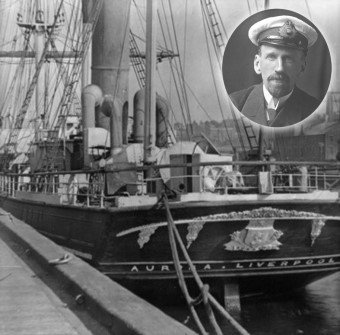Search the Community
Showing results for tags 'bottle'.
-
A Ship-in-a-bottle has been on my “bucket list” for some time now. A little while ago, I was re-enthused about such a project when I saw Glen McGuire's excellent rendition of this kit. A heavy hint was dropped to my wife, who duly produced the kit for my birthday in November last year. Completion of another modelling project, the holiday season, and work on a new furniture project has kept me out of the shipyard until now. I will forgo the “unboxing” photos as there are several of these already on the forum. Suffice to say that the only item that immediately jumps out at me for replacement are the sails. These have heavy black lines drawn on them and they look nothing like the box art. I have asked the Admiral (an avid sewer) for some assistance in sourcing an appropriate replacement material. The Hull Building commences with the hull, which is assembled from a series of lifts. I have read in other build logs where some have found that these did not accurately match the 1:1 templates provided in the instructions, however I was pleased to find that in my kit at least, they were a very close match. These templates each have a couple of crosses on them, that I can only assume to be alignment marks. The instructions are silent on this point, and I do not recall reading in anyone else’s log where they have been put to use. The instructions simply invite you to assemble the lifts in numerical order, with no further guidance on alignment. I decided to make use of these marks to help align the lifts correctly. I scanned the 1:1 scale drawing, printed it and cut out the individual patterns. I then pasted these temporarily onto the lifts with a UHU glue stick and drilled a 0.8mm diameter hole through each of the reference marks. The paper templates were then peeled off, leaving the lifts ready to be assembled. I used two pieces of 0.8mm diameter brass rod to dry fit the lifts together. There are several more lifts to be added under the stern, but these will be fitted in two pieces to accommodate the keel. This seems to have been a reasonably successful process, so I will now go ahead and glue them up. It feels good to be back at the bench!
-
Well, I was gonna skip doing a build log for this project because I intended to just make a quick SIB for my niece as a gift. But I got a little nudge from @Keith Black and @Knocklouder to start one, so we’re going to jump into this thing in progress. I’m almost done building the ship but much work remains inside and outside the bottle. The Backstory Some time ago, my brother received a $200 bottle of scotch as a gift and just recently gave me the bottle. Of course, the bottle was empty just like the Kraken rum bottle I got from a friend last year 😠. I need to choose better friends and brothers I guess. My brother has a daughter named Jenny, so I thought it would be cool to find a ship named Jenny and make a SIB as a gift. I started looking around to see if there were any interesting ships named Jenny. The only one I could find was one called the "Ghost Ship Jenny". Of course that intrigued me right away. Ghost Ship Jenny The Jenny was an early 1800’s 3-masted English schooner. In 1822, she left her home port on the Isle of Wight in southern England for a journey to Callao, Peru on the eastern coast of South America. Late in the year, unbeknownst to anyone, she got trapped in ice on the return trip while navigating the Drake Passage between the southern tip of Chile and Antarctica. Seventeen years later (1839), a whaling boat named Hope was navigating the Drake passage and spotted a large schooner drifting among broken ice floes. The Hope’s captain and several crew members rowed over to the ship and boarded her. They discovered it was the long-lost Jenny. The entire crew was found dead with their bodies well preserved by the cold. Many of the forgotten crew were still lying in their hammocks. The Jenny’s captain was frozen at his desk hunched over his last log entry, “May 4, 1823. No food for 71 days. I am the only one left alive.” Real story or Fake News? Adding to the intrigue is the fact that there's a lot of uncertainty about whether the story is true or a just a chilling legend. Jenny’s tragic plight was written about in several periodicals during the 1840’s, but none of the publications cited specific sources that referenced either the Jenny or the Hope. There is also speculation that Jenny’s story was, perhaps, a retelling of another event that happened to a ship named Octavius that was found near Greenland 50 years earlier, both sharing remarkably similar circumstances, albeit in a different century and opposite end of the globe. Ghost Ship Jenny the SIB So I thought that was compelling enough for the subject of a SIB. There aren't any pictures of the Jenny to build from (since no one is certain she was even real) so I've got a lot of artistic license. There also don't appear to be a lot of 3-masted schooners from that time, but I did find a painting of what looks like an 1800s era 3-masted schooner as well as an early 1900s Dutch one called the Oosterschelde, both of which I am using as a guide for my Jenny. My idea is to show the Jenny inside the bottle trapped by small icebergs. I want her to looked like she's been stranded there for many years, so I’m shredding and smudging her sails to give them a tattered look as well as trying to figure out other ways to make her look ravaged by the cold and weather. Here’s a couple of pics I’m using as a rough idea for a ship trapped in ice and tattered sails. The penguins are feeling right at home and clamoring loudly to horn their way into this build. I've held them off for now, but not sure if I can for much longer...
- 88 replies
-
- Ghost Ship
- Jenny
-
(and 1 more)
Tagged with:
-
I’ve really enjoyed the challenge of doing different water effects for the base of my last two projects – the Kraken and Archimedes’ Claw. I wanted to continue along those lines with the next project, but still try something new. I’ve always loved waterfalls, so why not try to build a SIB project around one? OK. Waterfall for the base. Now what? When I think of waterfalls, I think of Hawaii. So I decided that I’d go for what I consider a typical Hawaiian waterfall – ribbons of water bouncing down a broken rock face into a pool of pristine water surrounded by lush greenery. Something like this: As for the ship in the bottle, my first thought was a traditional age of sail ship with a historical connection to the Hawaiian islands. One option was Captain James Cook’s HMS Resolution, which he was aboard when he discovered Kauai in 1778. Another possibility was Cleopatra’s Barge which was a two-masted brigantine purchased by King Kamehameha II in 1820. However, after doing a lot of reading about ancient Hawaiian and Polynesian ocean travel, I became fascinated with the early voyager canoes that were used by natives to travel long distances between islands on rough, open seas. I was also fascinated by the almost spiritual reverence the Polynesians held for these vessels, which was evident in both their construction methods and subsequent care. Polynesia encompasses almost 120,000 square miles of the Pacific Ocean and includes over 1000 islands. The names, construction and function of the voyager canoes varied depending upon where in this vast expanse they were primarily used. For the ancient Hawaiians, the traditional name for a canoe was Wa’a. The design of the Wa’a evolved from earlier Polynesian ocean canoes called Vakas. The Wa’a was designed for propulsion by both sail and oar and tailored to the geography surrounding the Hawiian islands. With no barrier reefs protecting the Hawaiian Islands, the Wa’a had to be able to navigate large ocean swells closer to shore. For my project, I made the decision to build a double-hulled Hawaiian canoe which is called a Wa’a Kaulua. OK. Waterfall base – check. Wa’a Kaulua canoe in the bottle – check. Now, does the bottle just sit in the pool of water at the base of the waterfall? Hmmmmm. That seems kind of boring. Then an idea popped into mind – what about having the bottle opening nestle up against the waterfall’s cascade, but a portion of the falling water splashes off a small outcropping and diverts into the bottle as it it’s filling up the bottle with water? Crude powerpoint illustration: So that’s the plan! And without further ado, here we go!
- 174 replies
-
- Waa Kaulua
- bottle
-
(and 1 more)
Tagged with:
-
Some time ago I promised my wife to make for her a ship in a bottle larger sizes than previously made. I begin to fulfill a promise - it will the model of the steam schooner with the glorious history and the symbolic name "LENA". History: The wind power meets the power of steam in late 1800’s . In this period of maritime history, a hybrid generation of ships appeared combining these two. They kept the glory of sail ships and added independency from wind. Lena is a little steam schooner like that. She was launched in 1875 in Sweden by Motala. She was 26.8m long, 4.95m wide and 2.59m deep. While sailing by wind, the funnel tilts back so that the sail boom can move freely. She has an interesting story beginning with Nils Adolf Erik Nordenskiöld’s polar expedition. She joined the expedition as an auxiliary ship up to a point. She took part in Russian revolutions. She was reconstructed several times. Once in 1938. She was extended two meters in length, a new boiler was installed and living quarters were rebuilt. In 1959, she was planned to be reserved as a historical vessel. But the attempts failed in 1967, the damage she suffered was beyond repair. But the model ship builders will help her to live forever. - by Captain from Free Ship Plans Best REgards! Igor.
-
Every time I set out I think "no more split hull!!!" And then promptly ignore that and do a split. The Endeavor has a deep keel and draught, and plenty of sails. So split hull it is. She also has a rigging that boggles the mind. Not my mind, I lost that looong ago. This time I did not spend hours drafting her myself, I took a short cut in the form of a download-able model. I can post the link if someone is interested. The owner sells these for $5us I think, and has a few more. I had to add the life boat as well as the rear windows. Not sure if those are called portholes. This saved me plenty of time, but I'll have to drill more holes. This particular printing resin doesn't like to be drilled. We'll see
-
Gday all. Been keen to do a SIB since university days, after I've seen the first Pirates of the Caribbean movie. Back then forums like these were not really to be found. Plus starting career family etc. My lovely wife gave me the Amati Hannah kit for a present two years ago. That was a good learning start. I hope to work my way up from beginner to advanced, to master, and perhaps one day Igor's level My first scratch build is something simple and different. And that will hopefully fit the bottle I have laying around. Not really a fan of the Americas cup, but a great fan of the Ineos Grenadier. Looking forward to the build, and mostly advice from everyone. I read the copyright policy. Please delete if a screenshot is a breach? Thanks Obus
-
Since finishing the Aurora a few weeks ago, I found myself stressing out about all the yardwork and home fix-up things needing attention. I figured the only way out of that trap was to get started on another ship project. So I took a trip to Total Wine looking for cheap alcohol in unique bottles. You get some interesting reactions from store clerks when they see you grabbing bottles off the shelf, turning them sideways, and just staring at them. After an hour of perusing the aisles, a bottle of Cruzan rum with a longer neck caught my eye (1st pic below). When I turned it sideways, it sort of looked like a cannon barrel to me. Or maybe I had too many of the numerous free samples they were giving out around the store. Regardless, I got this idea about a display with a warship in the bottle and the bottle sitting in a cannon carriage. Hmmmmm. So I bought the $20 bottle of Cruzan. That’s over my usual budget for this stuff, but I do like rum drinks so it won’t go to waste like the rotgut I bought for the Aurora. I did some searching to see if I could find where someone else had done a similar SIB. I found several cannon carriage wine bottle holders for sale but nothing with a ship in the bottle. So maybe I’ve got something that’s a bit unique here, which would be pretty cool. Next was deciding what warship to build. I went thru Chapelle’s book on US naval history as well as the Naval History and Heritage Command website and decided on the USS Independence - the 1814 version and not the later Razee (new term I learned in my research). I liked the name of the ship, its history, and the fact that it was the first US Navy ship-of-the-line. Plus, a ship armed with 90 cannons would be a new challenge for me compared to my previous builds of commercial ships (Morgan and Aurora). The 2nd pic shows the basic concept I’ve got in mind.
- 177 replies
-
- Independence
- bottle
-
(and 1 more)
Tagged with:
-
An old idea of mine was to put a Ship in a bottle, but I didn't (and still don't really) have any idea about old rigged sailing ships. So the idea was to put a modern vessel in a bottle, however due to their generally large lengths and slender shapes, they would become so narrow and low that they'd fit through the neck of a bottle without any manipulation. Recently however I found a vessel with acceptable measurements and a good challenge to put in a bottle. During research I never quite found a good guide around the net, but recently I discovered this board and Glenn McGuire's (as well as IgorSky and others') build logs. Their ideas gave me the right input to start my first own SIB. So here it comes. As the title says, the ship is the Sea Installer from the DEME company. She is a jack-up wind installation vessel used for installing foundations on the seabed, mounting transition pieces on top of installed foundations as well as complete windmills on top of those transition pieces. She is one of the rare versions of these vessels that jacks herself up on cylindrical legs (= like ship's masts) rather than lattice legs, which makes her suitable. Following Glenn's builds my idea was now to put a seafloor of acrylic gel mixed with sand on the bottom to have a solid floor. Then I'd install the vessel on her legs and pour transparent epoxy to simulate the water layer. I was warned by Glenn's posts about the extremely slow drying times inside bottles, so I tried several things to solve this issue. Since the acrylic-sand-water mix is basically hardening by evaporating the water, I put it on one of my central heating heaters and when droplets started forming on top, I inserted a styrene tube and blew with my airbrush compressor through that tube. This way you insert relatively dry air inside the end of the bottle and the moist air is pushed out through the neck, around the tube. Once the droplets were gone again, I stopped and let it sit untill droplets formed again. Here is a picture of that process. The small diameter tube is inside. Since I never tried anything like this before, I decided to invest in a full size prototype to trial the engineering behind my build. This gave me an idea of the size I'd be dealing with and the issues I might have. Here she is standing next to the original leg design (based on the hinging mechanism for sailing ships I picked up over here. The idea was to hide the hinge by pulling the hull over them. Although I had a tight fit around those hinges, I was affraid the leg would drop out while inserting it into the bottle or pushing the hull unevenly over the four legs with no room for correction inside the bottle. So I decided to make a reduction in diameter around the hinge with smaller holes in the hull. This way the leg would not be able to fall down during inserting, and the hull would not be pushed to deep on any of the legs, since it would rest on the larger diameter lower section.
- 51 replies
-
- Sea Installer
- Bottle
-
(and 1 more)
Tagged with:
-
The concept for this project was inspired by @Ian_Grant's amazing build of a working quadrireme. I have been following that build for a long time and it has been an object of utter fascination for me. While I don’t have a fraction of the mechanical engineering skills required to do what Ian is doing, I did think it would be a cool idea to put a quadrireme or quadrireme-type ship in a bottle. In choosing a ship for a project, I am drawn to ones that are unique and/or have an interesting story - ships that have historical significance but might be a bit off the beaten path. I also want to pick something that offers an opportunity for an interesting presentation. So after deciding I wanted to do a quadrireme type of ship, I started digging around and stumbled upon something called the “Claw of Archimedes.” Brief History Archimedes was a Greek mathematician who lived in the city of Syracuse from 287 to 212 BC. Many consider him to be the greatest mathematician of ancient history and credit him with laying the foundation for calculus, approximating the value of Pi, and a host of other mathematical achievements. In addition, he was also a renowned inventor. During the second Punic war between Rome and Carthage (218 to 201 BC), King Hiero of Syracuse tasked Archimedes with devising a defense for the seawalls of Syracuse. The king’s particular concern was an amphibious assault from Roman quinqueremes under the command of Marcus Claudius Marcellus. Archimedes solution was to build a mechanical contraption which became known as the Claw of Archimedes. The Greek historian Polybius described the claw’s build and performance: “…(the claw) let down an iron hand swung on a chain, by which the man who guided the crane, having fastened on some part of the prow where he could get a hold, pressed down the lever of the machine inside the wall; and when he had thus lifted the prow and made the vessel rest upright on its stern, he fastened the lever of his machine so that it could not be moved; and then suddenly slackened the hand and chain by means of a rope and pulley.” Here's a couple of artist's renderings of how it worked: Multiple claws were deployed along the Syracuse seawall and were used effectively during the siege, sinking or damaging many of the Roman quinqueremes and causing much destruction of the fleet and soldiers. While the Romans eventually breeched the seawall of Syracuse and stormed the city, the claws protracted the battle and were credited with large casualties on the Roman side. Unfortunately, Archimedes eventually lost his life during the siege despite Roman orders not to kill him.
- 290 replies
-
- Quinquereme
- Finished
-
(and 1 more)
Tagged with:
-
Visiting my younger brother over December, he had an empty bottle of Hennessy Cognac that he refuse to throw away for some reason. His wife wants it out. So I snuck it out without their knowledge😈 I've wondered what would be a good ship as a gift for him, but he's not into it at all. He likes fantasy Viking stuff so for a while I was considering that. Didn't feel right, Vikings in a French bottle. I wanted to keep the label on. Then it hit me, we both loved Asterix growing up. Hard choice which one to choose, in the end I settled on The Great Crossing. We'll see how it comes out.... I'll apply all the lessons learned from the Schooner Wyoming build. Photos in the morning, some minor progress.
-
Good afternoon: The first thing would be to apologize for having written in Spanish... but that would be a lie. I write in Spanish in Google translate, I copy the English translation and I always have it. Let's see if this tenth attempt goes well and if not don't blame me and see if someone with more knowledge in this tells me what can happen and how to solve it, thanks. I have already identified the problem every time I edit two or three paragraphs, I have to go image by image and click to edit, all of the above is passed from English to Spanish. I'm going to see if I can do it in one fell swoop, and if it doesn't work, I give up. Let's do it on an eleventh try. The junk is possibly one of the oldest known sailing ships, having been documented to appear in 600 BC and is still in use in many parts of Southeast Asia. The technique of manufacturing watertight compartments from Chinese junks. The hull has a short stern and no keel. They were the signature ships of the China Sea and were used by both Genghis Khan and Kublai Khan in their attempts to conquer Japan. It was produced both for war and for trade. In the 9th century AD. C., Chinese junks transported goods to Indonesia and India. Its sails are made of thick fabric joined with reeds, which gave it great stability and great thrust. The rudder was removable and higher than in common ships, which allowed it to navigate in shallow water. It was one of the favorite ships for piracy on those shores. They were typical throughout the Asian area, with subtle morphological differences between them, but the essence is the same in all of them. I was able to make this boat from plans, which was a real relief for me, because of the ease of having all the measurements, mast angles, deck accessories, etc. once its size has been adjusted to the bottle. It was my fourth boat and I hadn't officially finished it yet, so I hope to do it here. He met problems and challenges as they arose and relied on imagination and invention to get him through. They are missing because some images have been lost but I think the most important thing is. I'll try to explain the process as best I can, but don't forget to use Google translate. Thais is the plan I usted. The technique regarding the hull is the hull divided into two to be able to access the inside of the bottle. Solid hull, we cut the main shape with a fret saw, which we carve with knives, files and fine-tune with sandpaper. Scroll saw and try to get as close as possible to the shape and curves of the ship. There's a lot of work left on that hull, and pictures are missing but it's all razor and sandpaper work. The different forecastles and sterncastles are also well prepared following the plan. With some tinted and adjusted polo sticks we will make the tops and simulate the planking scratching the stick with a pointed tool, not sharp, I used a fine nail to improve the point. We have advanced in the hull, the decks and the masts, all following the dimensions of the plan, we have painted the hull inspired by a photo on the internet in which one appears with red sails. We also have the keel made The masts have pins at their base that penetrate their respective holes in the deck. It facilitates the work and at the time of assembly the ventral part will only be cut one or two millimeters so that it does not collide with the glass roof of the bottle and to be able to assemble them. Prepare a mold to give the sails a little curvature to simulate the effect of the wind, there are those who maintain that the sails of a junk or sampan do not bend due to the effect of the wind, If they are made of interlaced bamboo, you will not see the bulging effect of the air, if they are fabric, don't hesitate, they will bulge. Well, the mold is made from Chinese skewer tips and, for the most part, ear swabs. The fabric is adjusted, taking care to insert kitchen paper between the mold and the fabric. The fabric is soaked with water and pva in equal parts and adjusted to the mold, we will always cut more fabric than necessary after adjusting the cut. Once dry, the crossbars are made by sharpening toothpicks with sandpaper to sharpen them. The Sails are already configured to suit you, exactly the same as the plan, they are sewn to the mast, thread and needle and we reserve them for when they have to be finished. Cheers
-
As a birthday present I received the Amati kit for the Golden Yacht (in a bottle) which was a total surprise. The box states this will be a Museum quality wooden model. I will be very surprised if I can build any wooden model to be suitable for display in a museum. Once I have completed sanding the Indy hull I will take a short break to have a look at start building this kit, which will become a side project. Having opened the box the parts all look very small. Having been spoilt for high quality pictures and instructions with the various Vanguard Model kits I have built the Amati instructions seem a little bit threadbare in comparison.
- 2 replies
-
- Golden Yacht
- amati
-
(and 1 more)
Tagged with:
-
Early last year, a good friend gave me a bottle of Kraken rum thinking I could use it for a future SIB project. I’d consider him a great friend had there still been rum in the bottle, but since it was empty he’s only a good friend. It’s the thought that counts though, right? So after finishing up the Adventure Galley SIB, I decided it was time to do something with the Kraken bottle. But what exactly? I wasn’t real familiar with what the Kraken was, so I started googling. Most pictures I found showed a huge octopus-looking thing wrapping its tentacles around a sailing ship. Hmmmm. For some weird reason, it made me think of the 80’s and something that you’d find in just about every honky-tonk bar and high-class living room in Texas back then - an armadillo on it’s back holding up a bottle of Lone Star beer like it was fixing to drink it. Then the dim light bulb in my head flickered on. Why not try to make a SIB where the Kraken is acting like the armadillo, holding the SIB above the water like it’s trying to drink the ship out of the bottle? The bad news was sculpting a Kraken creature would take skills way beyond my abilities. The good news was that the friend who gave me the Kraken bottle also happens to be an incredibly talented artist who does amazing carvings and sculptings. So I threw out the idea of a collaborative effort on this project. Unfortunately, the timing was not good for my friend so he declined. Which means I’m gonna try to do this whole project myself. Lord have mercy!
-
My third overall bottled ship, first scratch build of a ship that existed. I made the choice of a schooner because this would be the third go at it, and a 6 mast behemoth because of the bottle I have. It was a bottle of orange liqueur made by my brother-in-law. Passed down in his family, called Al Borducuan. Not something you'd find on the web. Which is why I wanted to use this bottle hoping he'll give me more of the stuff. At the same time I got a resin 3d printer at work. It occurred to me this thing gives way better accuracy than carving. With some self taught drafting "skills" i came up with this object below. I used Onshape, and not sure if the way I did it was correct. But the .stl could be generated from this. This is not my first attempt, I started out trying to keep deck furniture separate, but learned fine details print better if attached to the deck already. Anything less than 0.8mm does not really print well. Considerable trial and error here But I finally have a workable model: As you can see masts too short so reprint. I have to beef the masts and bowsprit up to where the resin is rigid. Too thin and it is very flexible. Hoping this doesn't make it look odd...
-
Hello, I have decided to make a ship in the bottle. Very much has to do with a few things. One its my nieces birthday and her name is Hannah , so I told her I would make her one. That's why I will start this log today , but I got to get set up for it. And I have to put my Pinta model away in it's display case, might take awhile lol. Two, it's @Glen McGuire fault. After reading his log I said I got to try that, so I bought one. Then I have read several others logs and booked mark them as well .I know I should take @Landlubber Mike advice and build it first then show it because of potential embarrassment 😳 lol But here goes I am hitting the bottle something I have not done in 38 years lol And I am close to 68 now lol. But I feel like a kid with a new toy , and these bottle builders like to play lol. So wish me luck I will need it, talk soon. BOB M.
-
As I was finishing the Independence build, my son who is a student of Asian history suggested that I do a Chinese junk ship in a bottle next. So when the Independence was done, I started playing around with what to do for the project. I came up with a few ideas for the display base, one being a sword holder, which my son particularly liked. We found one on Amazon for a samurai sword with a Chinese dragon carving. He really liked the design and I thought the shape would work well with the profile of a bottle - the neck would rest on the dragon’s head with the end of the bottle resting on the dragon’s tail.
- 194 replies
-
- Bottle
- Treasure Fleet
-
(and 3 more)
Tagged with:
-
My original plan was to build a pirate ship after I finished the Independence, but then my son intervened with his junk ship request. So now it’s time to circle back and take on a pirate ship. I wanted a pirate with an interesting story as well as an interesting ship. After considerable research, I decided on Captain Kidd’s Adventure Galley. I was intrigued by his personal story of pirate hunter turned pirate. Plus, the Adventure Galley was quite a unique ship. Here’s some background on the pirate, his ship, and the SIB concept I have in mind. The Pirate: Captain Kidd’s story is fascinating, although the particular details differ depending on the source. Basically, he was a pirate hunter turned pirate. He began as privateer commissioned by several noble lords of England (including King William III) to hunt pirates. He weighed anchor in the fall of 1696 and over the course of the next couple of years, captured several ships. In 1698, he took his greatest prize, the 400-ton Quedah Merchant, which was an Indian ship hired by Armenian merchants and carried a large treasure of gold, silver, silks and other valuables. Shortly afterwards, Kidd was declared a pirate by the same English Government that had given him his commission. By some accounts, it was because the Government’s view of privateering had changed. Others blamed it on his poor treatment of captured crewmen. Still others insisted that the East India Company, which had ties to the Quedah Merchant, pressured the crown as retaliation for Kidd’s capture of their prized ship. Regardless, he was lured to Boston with a false promise of clemency, but not before he supposedly stashed much of his treasure near Long Island, NY. After surrender, Kidd was extradited to London in 1701 and hung for piracy and murder. The Ship: Captain Kidd’s main ship was called the Adventure Galley. It was launched in 1696 and purchased by Kidd a year later. It was a 284 ton, 3-masted frigate equipped with 34 cannons and designed for a crew of 150 men. After capturing the Quedah Merchant, Kidd scuttled the Adventure Galley and took over the Indian ship, renaming it the Adventure Prize. I found the Adventure Galley unique because it was a hybrid, similar in a way to the steam/sail ships of the mid and late 1800s. Kidd’s ship featured square sails AND two banks of oars. The oars gave it maneuverability in calm seas – theoretically a significant advantage in combat. There are a number of fully assembled Adventure Galley models for sale by various makers. I find it interesting that most do not show the oars or even have ports for them. However, a company in Madagascar called Le Village displays a model on their website that does include the bank of oars. See below for a picture of the Le Village version. I will base my Adventure Galley loosely on their version but likely add some elements from other models and illustrations.
- 134 replies
-
- Captain Kidd
- bottle
-
(and 3 more)
Tagged with:
-
Hi to all! One more of my small and short projects. You can read the story of this boat HERE So, first, I made the basis of the boat's hull.
- 24 replies
-
- St Nicholas
- Finished
-
(and 1 more)
Tagged with:
-
ATLANTIC history Commissioned by New York Yacht Club member Wilson Marshall, Atlantic was launched in 1903. She was designed by William Gardner, one of America's foremost designers of large yachts. From the moment Atlantic went to sea, it was clear that she was an exceptionally fast and beautiful schooner. When a yacht in 1903 hits twenty knots during her sea trials, she is a promising yacht, but even then nobody could imagine two years later this yacht would set a record that would stand unmatched for almost a century. Nevertheless, whilst Wilson Marshall wanted Atlantic to be the fastest schooner on the water, he felt there was no reason to compromise on comfort. Unlike contemporary racing schooners, Atlantic was equipped with every imaginable luxury. Fitted out with the finest mahogany panelling, she had two steam driven generators to power electric lights, refrigerators and a large galley. On deck her halyard winches and primary sheet winches were also steam driven. She had two double and three single staterooms, a lobby, a large full beam saloon, a dining room, a chart & gunroom, three large bathrooms and in the deckhouse there was a comfortable observation room. She had retractable chimneys, so while under sail the below deck steam heating, lighting and refrigeration systems could keep running. Atlantic's fo'c'sle accommodated her thirty-nine strong crew and officers, who would live aboard throughout the year. During her first season Atlantic proved fast, winning both the Brenton Reef and the Cape May Cup hands down, but it was only in 1905 she made the headlines by winning the Kaiser's Cup, a Transatlantic race from Sandy Hook to the Lizard. Referred to as "The last Great race of Princes" the entries for this race included all the yachts that the rich and powerful from Britain and America could send to sea. The legendary Captain Charlie Barr, who had already successfully defended the America's Cup three times, was hired to skipper Atlantic. Charlie Barr's determination to win was as legendary as his skills for driving the largest of yachts to the very limit. And win, he did, sailing 3006 miles in 12 days, 4 hours, 1 minute and 19 seconds. Atlantic's 24-hour record was 341 miles, an average speed of 14,1 knots. Uncountable attempts were made to break this record but it would hold firm until 1998, the longest standing speed record in the history of yachting. Atlantic's story continued for another seventy-seven years with ownership passing through the likes of Cornelius van der Bilt and Gerald Lambert. She was used as a mother ship for other racing yachts like Vanity, for America's Cup defenders and the J-Class Yankee on her voyage to England. Her guest book included the rich and famous of the world. Simply put, she is the most famous and beloved racing schooner of all time. Although after World War II Atlantic would never sail again, she refused to give up her existence. Somehow she was saved from the scrap yard on three different occasions, broke loose from her moorings, to sail back to sea without a man aboard and ended up used as a houseboat, a restaurant and a floating dock at a fuel station. Finally on 30th of January 1982, she was broken up at Newport News Boat Harbor, Virginia. The Schooner Atlantic's General Specifications Design William Gardner Year Originally Built 1903 Length on Deck 185 Feet 56.43 Meters Waterline Length 135 Feet 41.18 Meters Beam 29 Feet 8.85 Meters Draught 16½ Feet 4.9 Meters Displacement 298 Tons 303 Tonnes Sail Area to Windward 18,500 Feet² 1,750 M² This information from the site www.schooner-atlantic.com So, I decided to construct model of this surprising schooner in a bottle.
-
I’m kinda getting hooked on these ship-in-bottle projects. Maybe because I’m impatient and can finish them in 2-3 months rather than a year (or years) like the full-size ship models. I’ve thought about borrowing @mtaylor's signature line and changing it to “The wood is patient but this shipwright is not!” So I think I’m going to do a few more SIBs before I pull my AL Constellation kit out of the closet. The best thing about completing my first scratch build SIB is that now the next project is not limited to what kits are available. But maybe that’s a problem too – figuring out what ship to do next! So after a lengthy debate, I have decided on the SY Aurora as a SIB. Most people know the Aurora as the “other” ship involved in the ill-fated Ernest Shackleton/Endurance attempt at a Trans-Antarctic expedition. However, I first came across the Aurora in books I’ve read about Douglas Mawson. He is a lesser-known Antarctic explorer, mainly because his goal was mapping and scientific exploration rather than trying to achieve a “first”, as in first to the South Pole or first to do a trans-continent trek, etc. If you have an interest in Antarctic exploration and have never read about his story of survival on the Australasian Antarctic Expedition, I highly recommend a couple of books, Home of the Blizzard by Mawson himself and Mawson’s Will by Lennard Bickel. Even the short Wikipedia writeup will leave you in awe of what a man can endure. The Aurora was a steam and sail barquentine with 1 funnel and 3 masts, with square sails only on the fore mast. It was originally launched in 1876 and later purchased by Mawson for his expedition in 1910. Hopefully I can do it justice with this build.
-
After finishing the Mamoli CSS Alabama and the Amati Hannah ship in a bottle, I have decided to dip my toe in the “dark side” as @Bob Cleek put it - the dark side being a scratch build. I don’t think I’m ready or skillful enough to do a large scratch model so I’m trying another ship in the bottle. The Hannah kit was a lot of fun. Hopefully this scratch effort will be even more so. After I finished the Hannah, a friend gave me a bottle for another ship in the bottle build. It’s a peach cider bottle that came from Fredericksburg, Texas (which is famous for its peaches). Fredericksburg is also the birthplace of Fleet Admiral Chester Nimitz so it’s got some nautical ties. My friend’s name is Morgan so I thought I’d try to build the Charles W. Morgan whaler and float it on an ocean in the bottle. 3 tall masts, 9 yards, and 19 sails! Oh boy. This is either going to be an amazing build or an epic fail. Only 1 way to find out which. Here we go!
- 71 replies
-
- Charles W Morgan
- bottle
-
(and 1 more)
Tagged with:
About us
Modelshipworld - Advancing Ship Modeling through Research
SSL Secured
Your security is important for us so this Website is SSL-Secured
NRG Mailing Address
Nautical Research Guild
237 South Lincoln Street
Westmont IL, 60559-1917
Model Ship World ® and the MSW logo are Registered Trademarks, and belong to the Nautical Research Guild (United States Patent and Trademark Office: No. 6,929,264 & No. 6,929,274, registered Dec. 20, 2022)
Helpful Links
About the NRG
If you enjoy building ship models that are historically accurate as well as beautiful, then The Nautical Research Guild (NRG) is just right for you.
The Guild is a non-profit educational organization whose mission is to “Advance Ship Modeling Through Research”. We provide support to our members in their efforts to raise the quality of their model ships.
The Nautical Research Guild has published our world-renowned quarterly magazine, The Nautical Research Journal, since 1955. The pages of the Journal are full of articles by accomplished ship modelers who show you how they create those exquisite details on their models, and by maritime historians who show you the correct details to build. The Journal is available in both print and digital editions. Go to the NRG web site (www.thenrg.org) to download a complimentary digital copy of the Journal. The NRG also publishes plan sets, books and compilations of back issues of the Journal and the former Ships in Scale and Model Ship Builder magazines.


